With more and more people looking to brighten up their indoor and outdoor spaces, it can be challenging to find the right plants for your space.
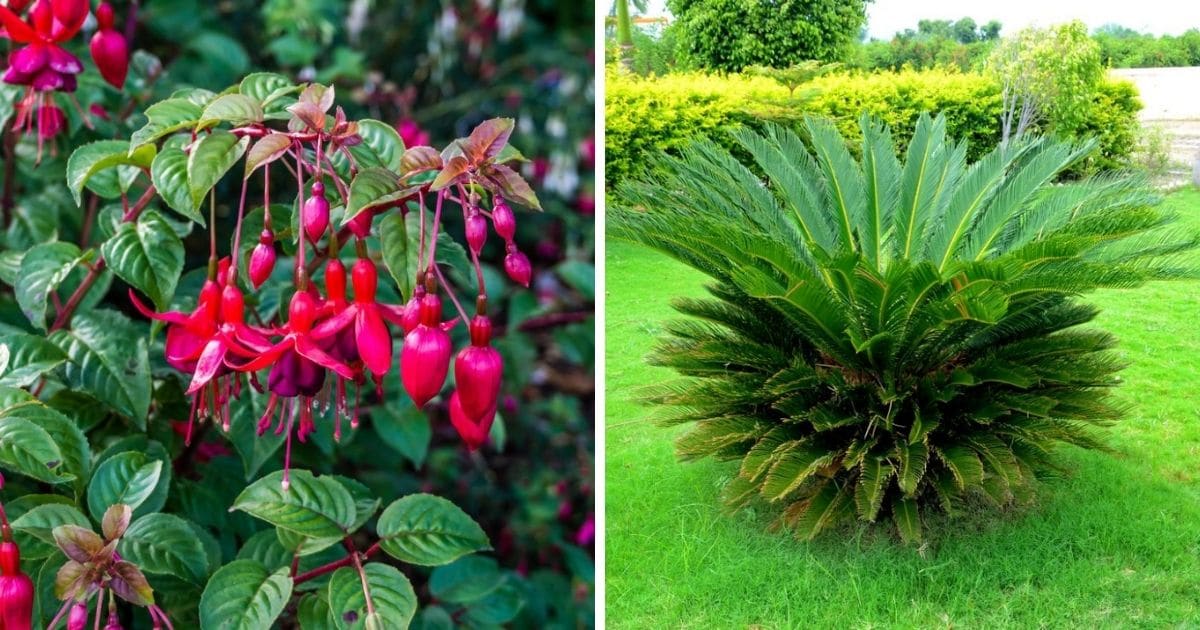
While we often think of plants bathing in the bright glow of a windowpane, many plants are able to survive, and some even thrive in areas where there is very little or no light.
Living in a place with low lighting is no reason to live without plants, which is why we’ve compiled this list of 45 plants that will grow just fine without sunlight.
Jump to:
- 1. Snake Plant (Sansevieria trifasciata)
- 2. ZZ Plant (Zamioculcas)
- 3. Peacock Plant (Maranta leuconeura)
- 4. Wax Begonia (Begonia x semperflorens-cultorem)
- 5. Nerve Plant (Fittonia spp.)
- 6. Peperomia (Peperomia spp.)
- 7. Rubber Tree (Ficus elastica)
- 8. Chinese Evergreen (Aglaonema)
- 9. Maidenhair Fern (Adiantum)
- 10. Rattlesnake Plant (Goeppertia insignis)
- 11. Golden Pothos (Epipremnum aureum)
- 12. Japanese Sago Palm (Cycas revoluta)
- 13. Bromeliad (Bromeliaceae)
- 14. Alocasia Silver Dragon (Alocasia baginda)
- 15. Orchid (Orchidaceae)
- 16. Money Tree (Pachira aquatica)
- 17. Parlor Palm (Chamaedorea elegans)
- 18. Silver Satin (Scindapsus pictus)
- 19. Panda Plant (Kalanchoe tomentosa)
- 20. Boston Fern (Nephrolepis exaltata)
- 21. English Ivy (Hedera helix)
- 22. Laceleaf (Anthurium spp.)
- 23. Dumb Cane (Dieffenbachia)
- 24. Sword Fern (Polystichum munitum)
- 25. The Paper plant (Fatsia Japonica)
- 26. Dwarf Umbrella Tree (Schefflera arboricola)
- 27. Lucky Bamboo (Dracaena sanderiana)
- 28. Arrowhead Plant (Syngonium podophyllum)
- 29. Swiss Cheese Plant (Monstera deliciosa)
- 30. Staghorn Fern (Platycerium)
- 31. Creeping Fig (Ficus pumila)
- 32. Zebra Cactus (Haworthia attenuata)
- 33. Cast Iron Plant (Aspidistra elatior)
- 34. Weeping Fig (Ficus benjamina)
- 35. Wax Plant (Hoya)
- 36. Bird’s Nest Fern (Asplenium nidus)
- 37. Elephant Ear (Colocasia esculenta)
- 38. Dragon Tree (Dracaena)
- 39. Christmas Cactus (Schlumbergera)
- 40. Peace Lily (Spathiphyllum)
- 41. Spider Plant (Chlorophytum comosum)
- 42. Chinese Money Plant (Pilea peperomioides)
- 43. Fuschia (Fuschia)
- 44. Aloe Vera (Aloe barbadensis miller)
- 45. Painted Leaf Begonia (Begonia rex)
- Final Thoughts
1. Snake Plant (Sansevieria trifasciata)
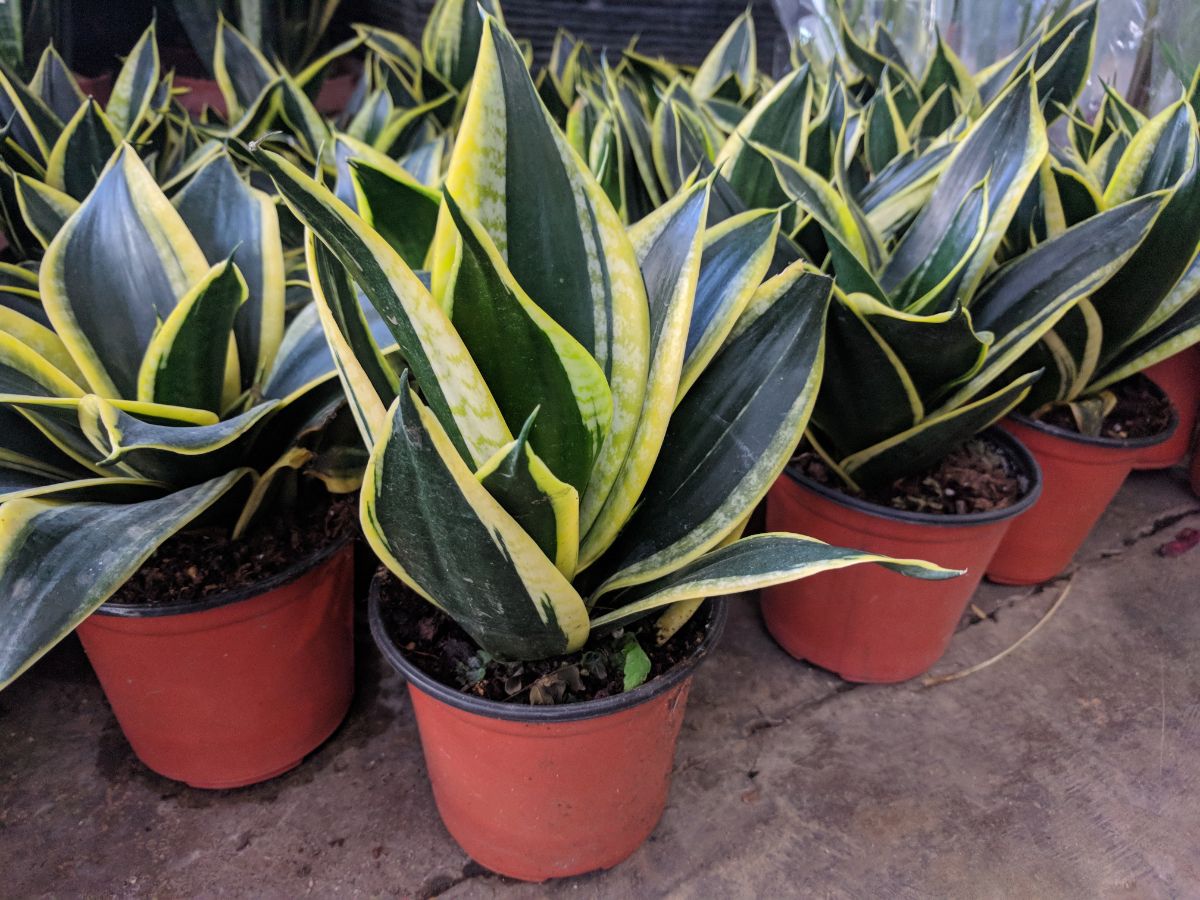
| Hardiness Zone: | 9-11 (USDA) |
| Water: | Allow the soil to dry out completely between watering |
| Sun: | Partial to complete shade |
The snake plant, also known as the mother-in-law’s tongue, belongs to the agave family comes in several varieties, all of which snake outward and end at a sharp point.
These plants are unbelievably tolerant of neglect and can grow in nearly any condition. They tolerate virtually no sunlight, although they may grow more slowly or not without access to natural light.
If you’re looking for an easy beginner plant that can handle little to no sunlight, the snake plant might be for you!
2. ZZ Plant (Zamioculcas)
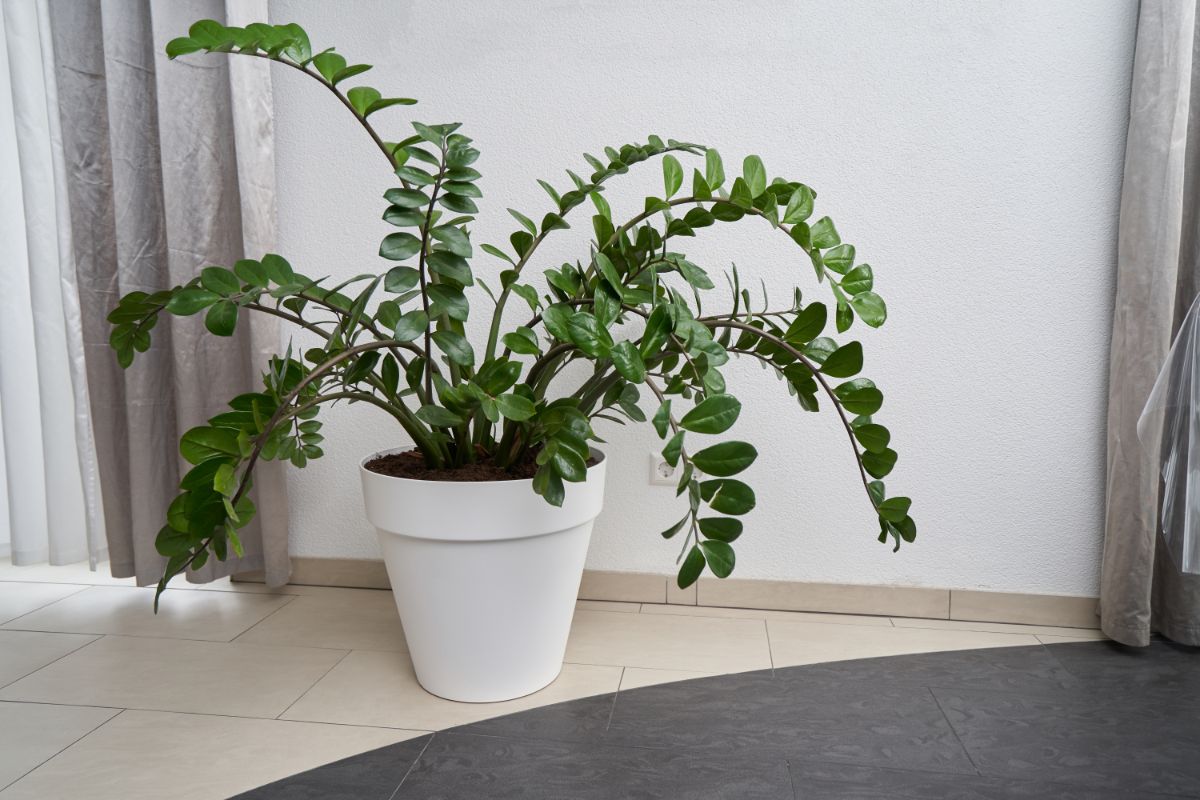
| Hardiness Zone: | 9-10 (USDA) |
| Water: | Allow the soil to dry out completely between watering |
| Sun: | Partial to complete shade |
If you’re looking for a plant that can withstand even the darkest corners of your house or the harsh fluorescent lighting of your basement, then the ZZ plant is for you.
ZZ plant, short for its botanical name Zamioculcas zamiifolia, has tall stems with deep green, shiny leaves. This beauty is a low-maintenance plant that loves deep, dark, shady areas and requires very little watering.
3. Peacock Plant (Maranta leuconeura)
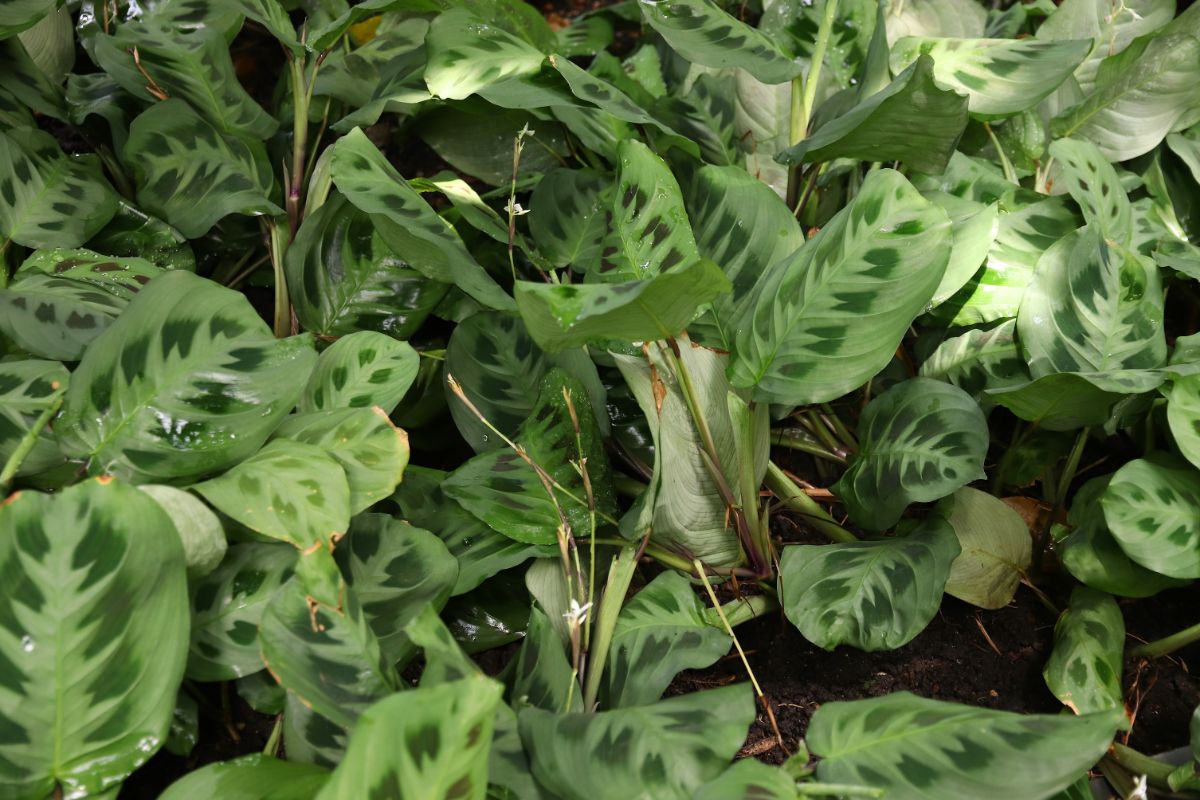
| Hardiness Zone: | 10-11 (USDA) |
| Water: | Water when the top few inches of soil are dry, mist leaves regulary |
| Sun: | Partial to complete shade |
Calathea, also commonly referred to as a peacock plant, is a real showstopper and a popular choice among houseplant lovers.
The peacock plant is also commonly called the prayer plant because it tends to curl inward and point upwards toward the sky in the evenings.
Be warned that the peacock plant is a slightly higher maintenance plant than most plants on the list and may benefit from being regularly misted and watered with distilled water.
4. Wax Begonia (Begonia x semperflorens-cultorem)
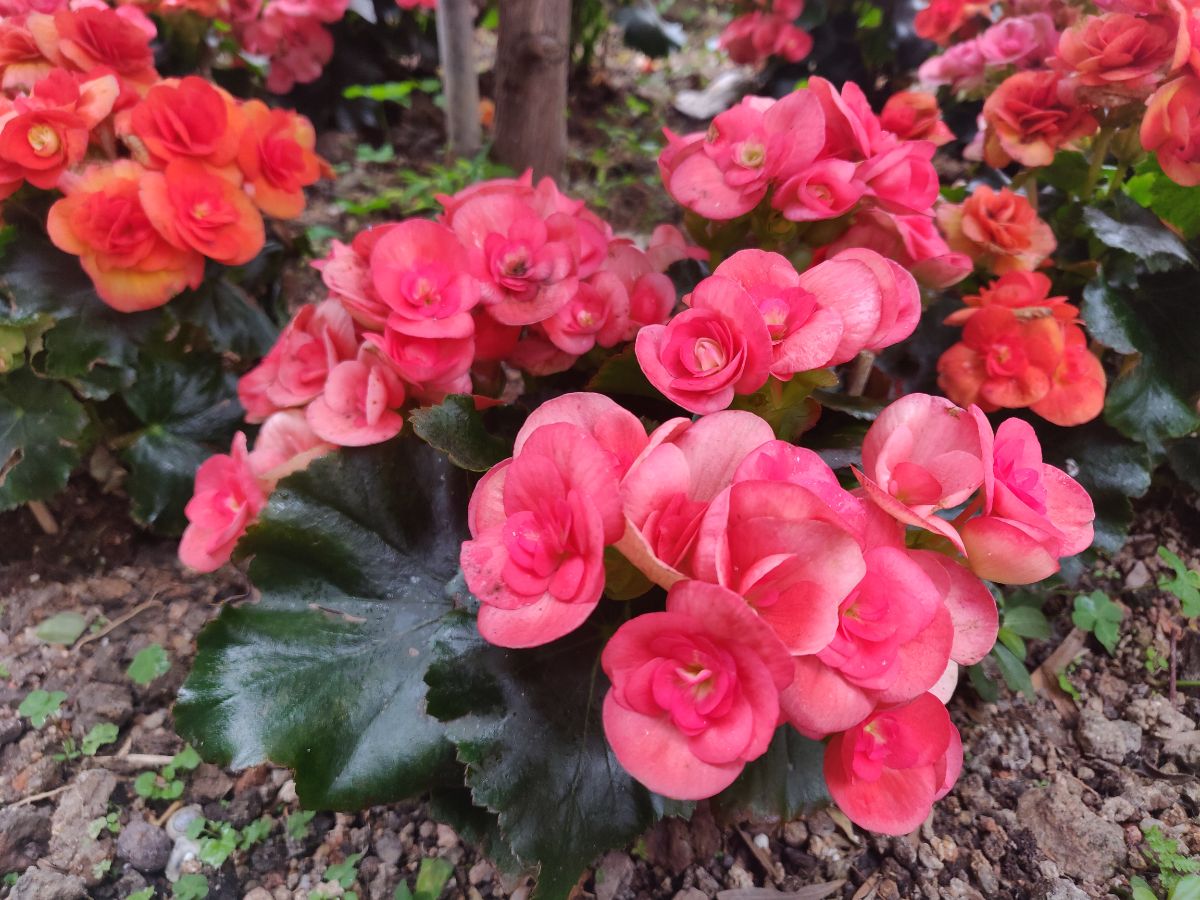
| Hardiness Zone: | 10-11 (USDA) |
| Water: | Water thoroughly, then allow the soil to dry out completely between watering |
| Sun: | Can tolerate most sun levels, does well with partial shade |
Wax begonias are beautiful plants that have the ability to flower nearly all year long in the right conditions.
They are petite plants with small, pink flowers that are sure to add some cheer to your living or outdoor space.
While wax begonias thrive in bright, indirect light areas, they will do fine in lower light areas, especially when it’s particularly warm outside.
5. Nerve Plant (Fittonia spp.)
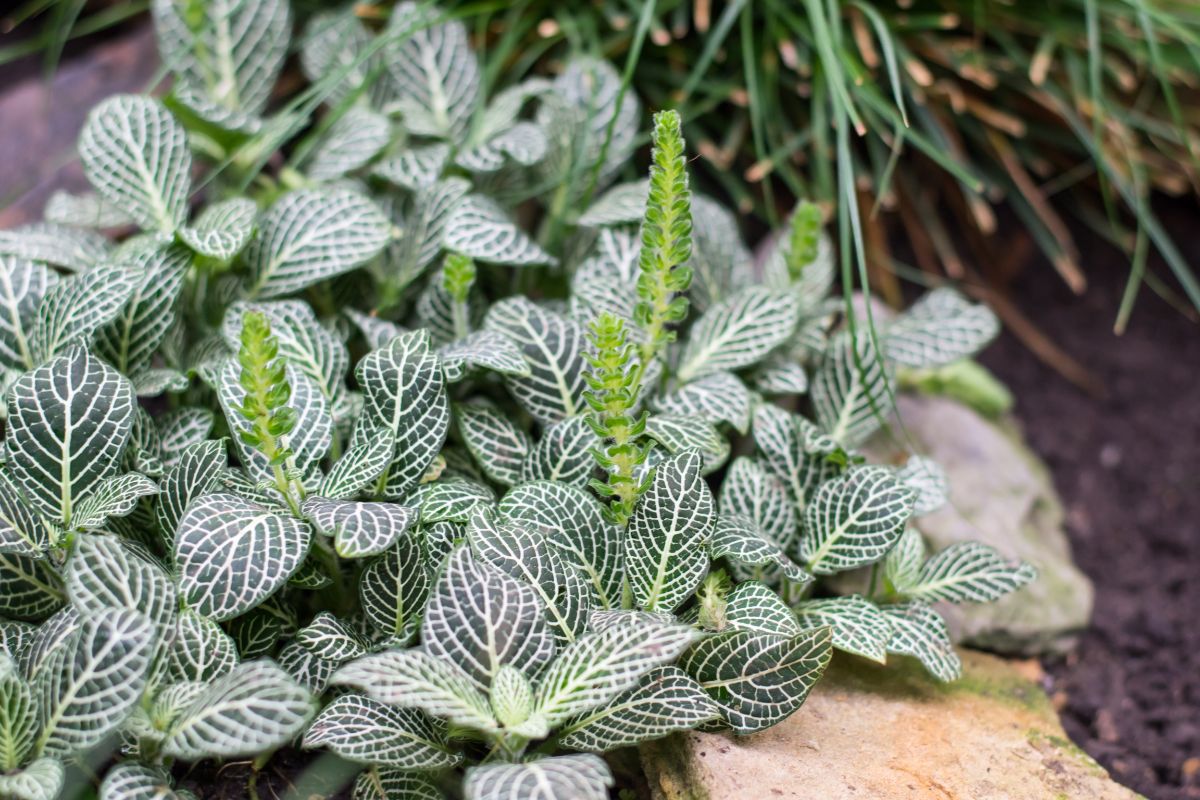
| Hardiness Zone: | 11 (USDA) |
| Water: | Water when the soil just starts to dry out, the soil should be kept moist, not wet, and shouldn't be allowed to dry out completely between watering |
| Sun: | Shade to indirect sunlight |
If you’re looking to add a delicate and understated plant to your collection, the nerve plant is an excellent choice.
Its small green leaves have beautiful veins that look almost drawn on and come in several colors.
Your nerve plant will require regular attention, as the soil should be kept moist, and multiple instances of leave wilting may result in permanent damage.
6. Peperomia (Peperomia spp.)
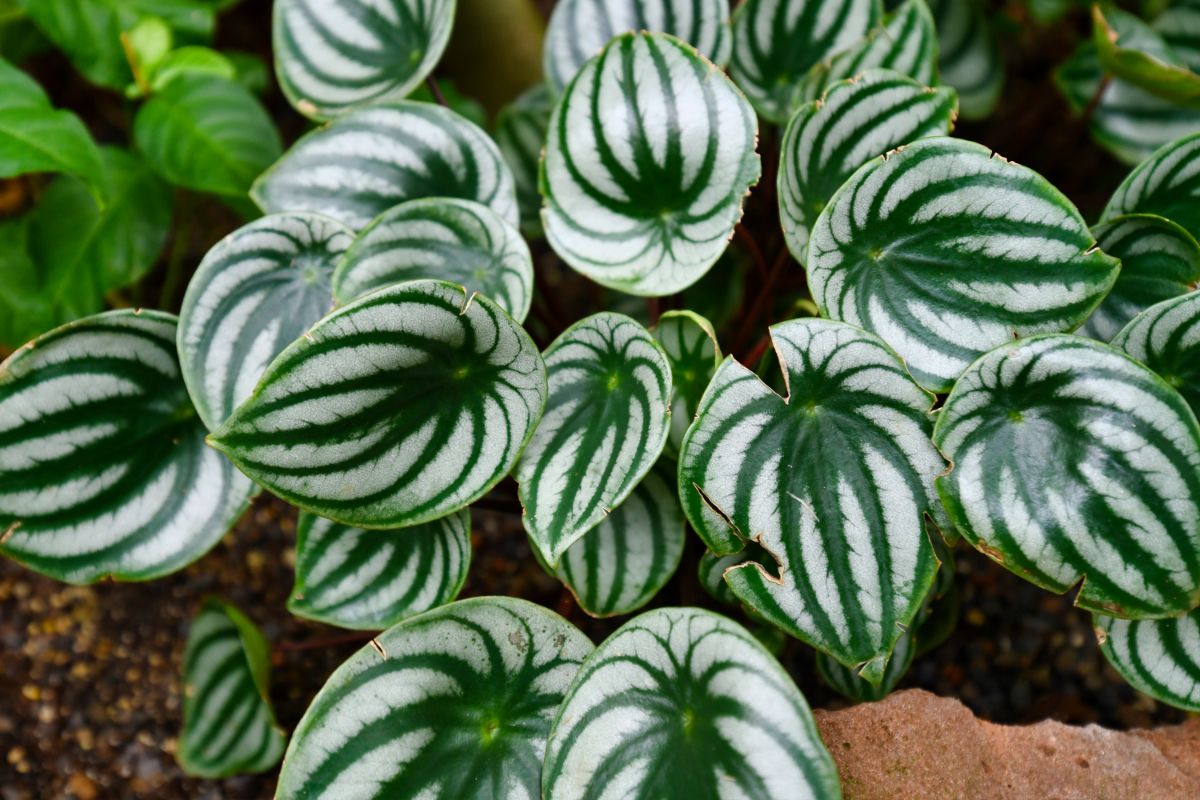
| Hardiness Zone: | 10-12 (USDA) |
| Water: | Allow the soil to dry out between watering |
| Sun: | Thrives in medium or bright indirect light |
Peperomia is a large family of plants that includes several popular houseplants. While its ideal growing conditions offer access to medium or bright indirect light to keep the plant healthy and the foliage colorful, peperomia is relatively tolerant of low-light conditions and is susceptible to damage if exposed to direct sunlight.
7. Rubber Tree (Ficus elastica)
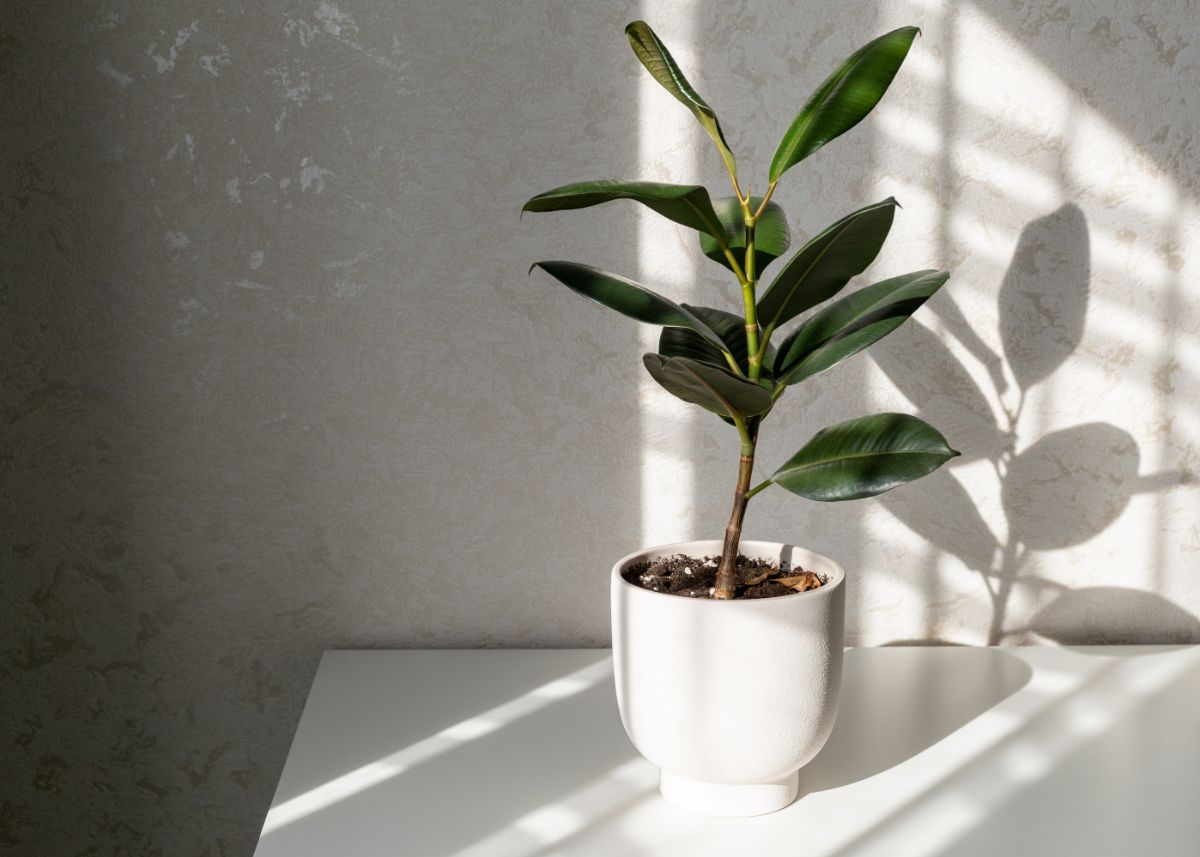
| Hardiness Zone: | 10-11 (USDA) |
| Water: | Water when the top few inches of soil begin to feel dry |
| Sun: | Indirect light, moderate sunlight |
The rubber tree has soared to one of the top houseplants used today and thrives when grown indoors.
Although it will grow well outside in USDA hardiness zones 10 and 11, most people choose to keep it inside, and with adequate natural light, it’s a relatively quick grower.
Don’t be surprised if the lower levels of leaves begin to fall off if your rubber tree never sees sunlight, but it does well in partial shade, so even if it’s not getting direct sunlight, your rubber tree should continue to grow and stay healthy.
8. Chinese Evergreen (Aglaonema)
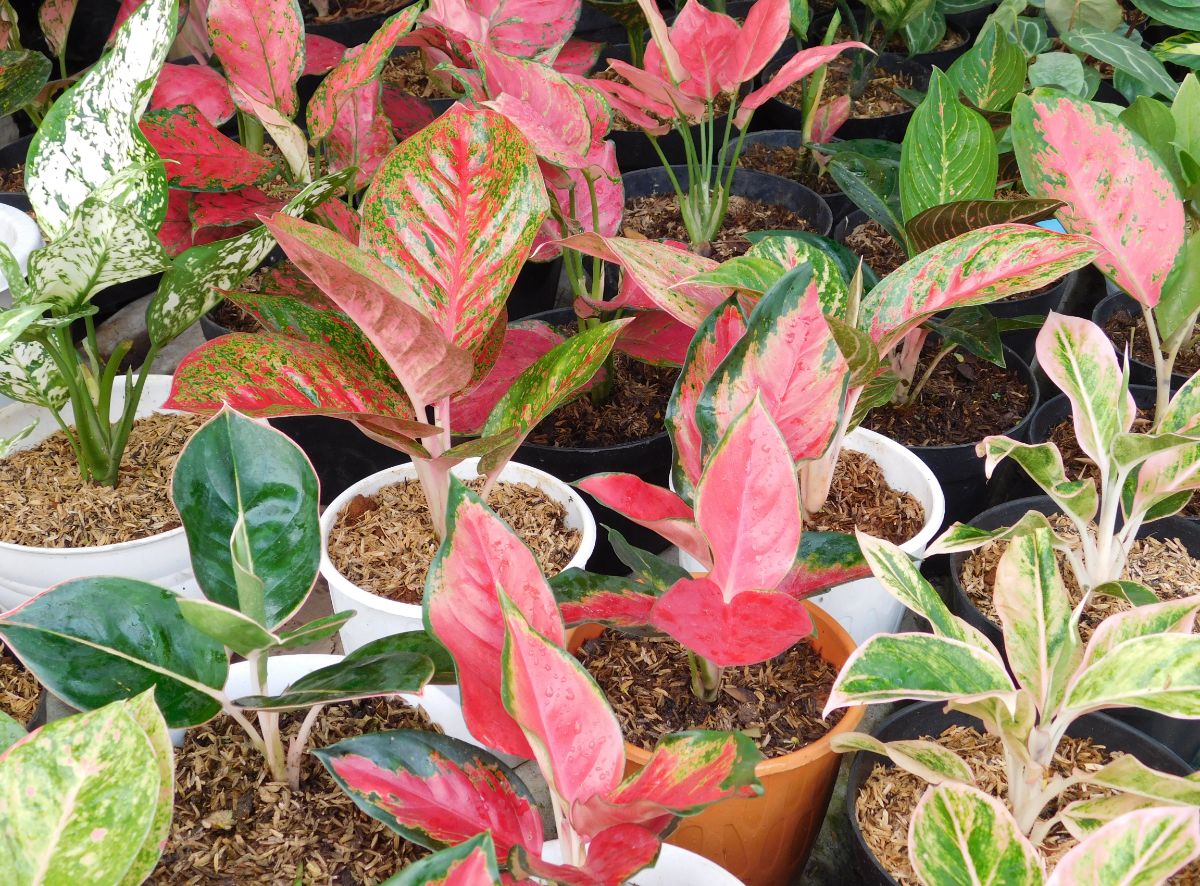
| Hardiness Zone: | 10-12 (USDA) |
| Water: | Water thoroughly, then allow the soil to dry out completely between watering |
| Sun: | Once adapted to low light, the plant will do fine and continue to grow at a slower rate |
Chinese Evergreens are great plants because they can adapt to various growing conditions and do just fine in low light conditions.
While the growth may be considerably slower, Chinese evergreens are already slow-growing plants, so you likely won’t notice a huge difference in their growth pattern.
Pick a nice shady spot for your Chinese evergreen, and it will continue to deliver consistent, beautiful foliage for years to come!
9. Maidenhair Fern (Adiantum)
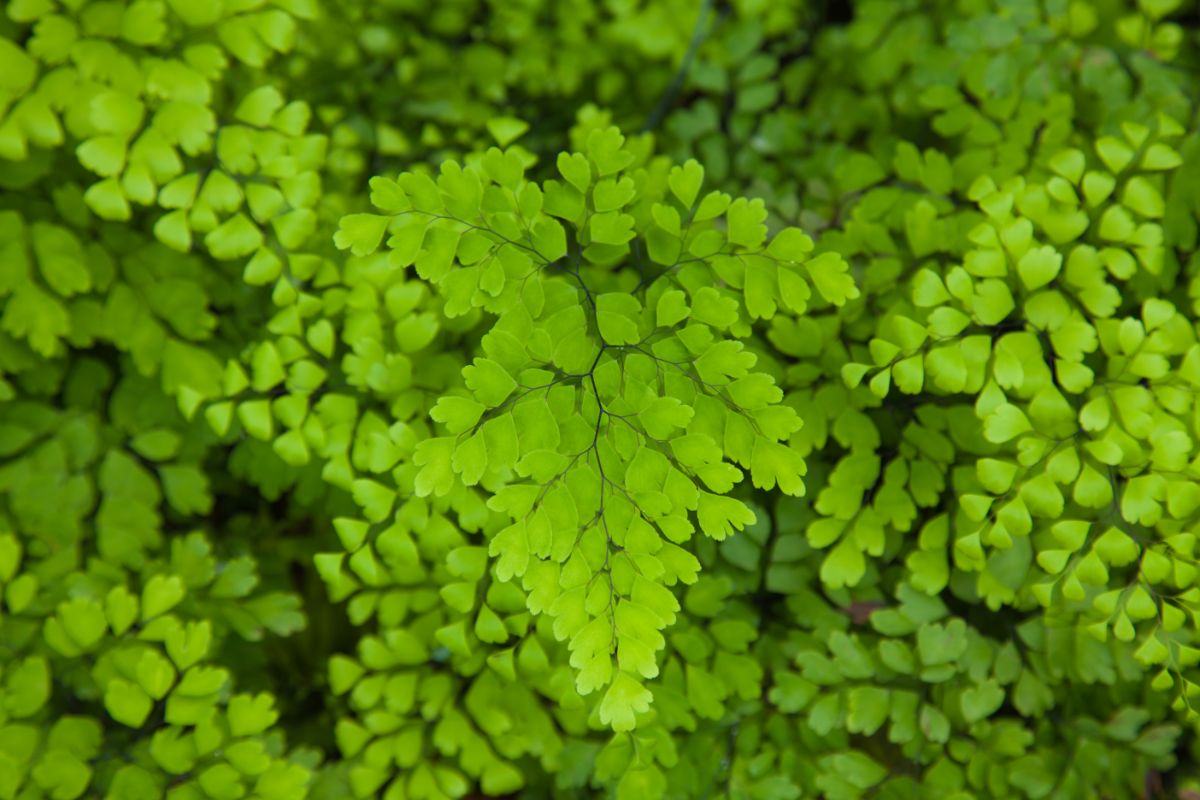
| Hardiness Zone: | 10-11 (USDA) |
| Water: | Keep the soil moist but not wet, water when you notice it begins to dry out |
| Sun: | Partial to complete shade |
Gorgeous when grown inside or outside, maidenhair ferns are delicate and beautiful plants that are rewarding to grow.
Like most ferns, the maidenhair fern tends to grow on the forest floor, underneath trees and larger plants, so it is well equipped to handle low-light situations.
If you’re looking to landscape darker areas of your yard, the maidenhair fern makes a great choice because it can thrive without direct sunlight and grow in various places, such as between rocks.
10. Rattlesnake Plant (Goeppertia insignis)
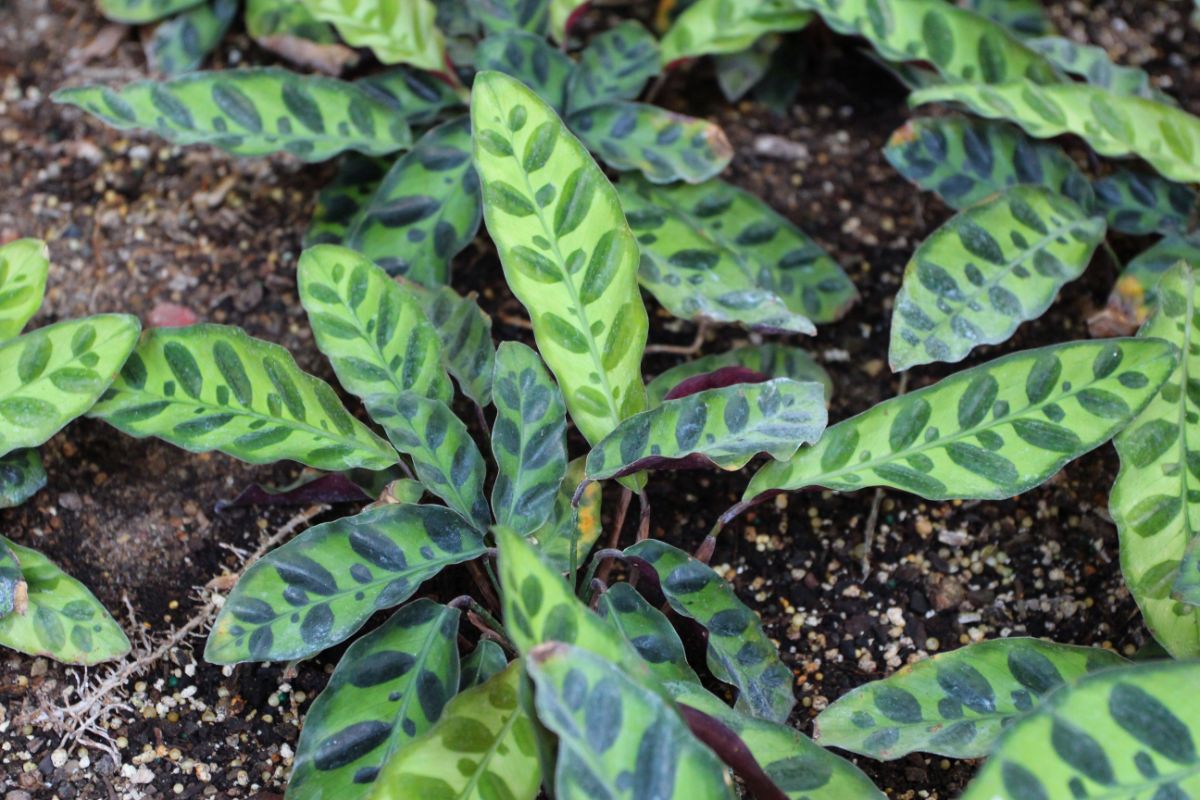
| Hardiness Zone: | 11-12 (USDA) |
| Water: | Keep the soil moist in warmer months but allow the top few inches of the soil to dry out between watering in the winter |
| Sun: | Partial to complete shade |
The rattlesnake plant is another type of calathea that is slightly fussy and completely beautiful.
Because of its tropical origins, this plant requires much more humidity than many plant owners have patience for.
However, if properly cared for, rattlesnake plants make extremely desirable houseplants because of their tall, striking foliage with distinct green markings on the top of the leaves and a purple-red hue making up their undersides.
11. Golden Pothos (Epipremnum aureum)
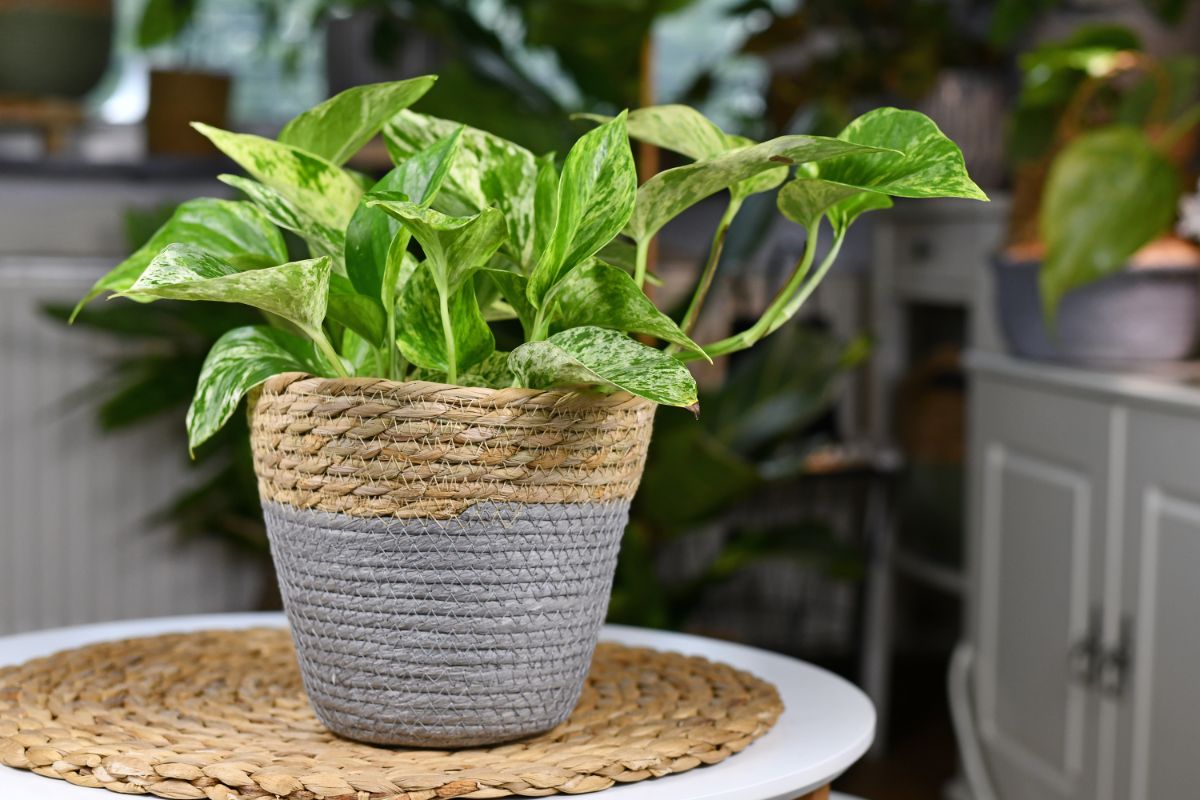
| Hardiness Zone: | 9-10 (USDA) |
| Water: | Allow the soil to dry out completely between watering, particularly when kept in low light conditions |
| Sun: | Thrives in bright, indirect sunlight but is tolerant of most light conditions |
Another favorite among houseplant lovers, the golden pothos is beloved for its bright and cheery foliage and virtual indestructibility.
Your golden pothos will likely survive in any conditions and will tell you when it needs to be watered through its slightly wilted leaves.
Tolerant of neglect, these common houseplants are also very tolerant of low light conditions; just expect slower growth!
12. Japanese Sago Palm (Cycas revoluta)
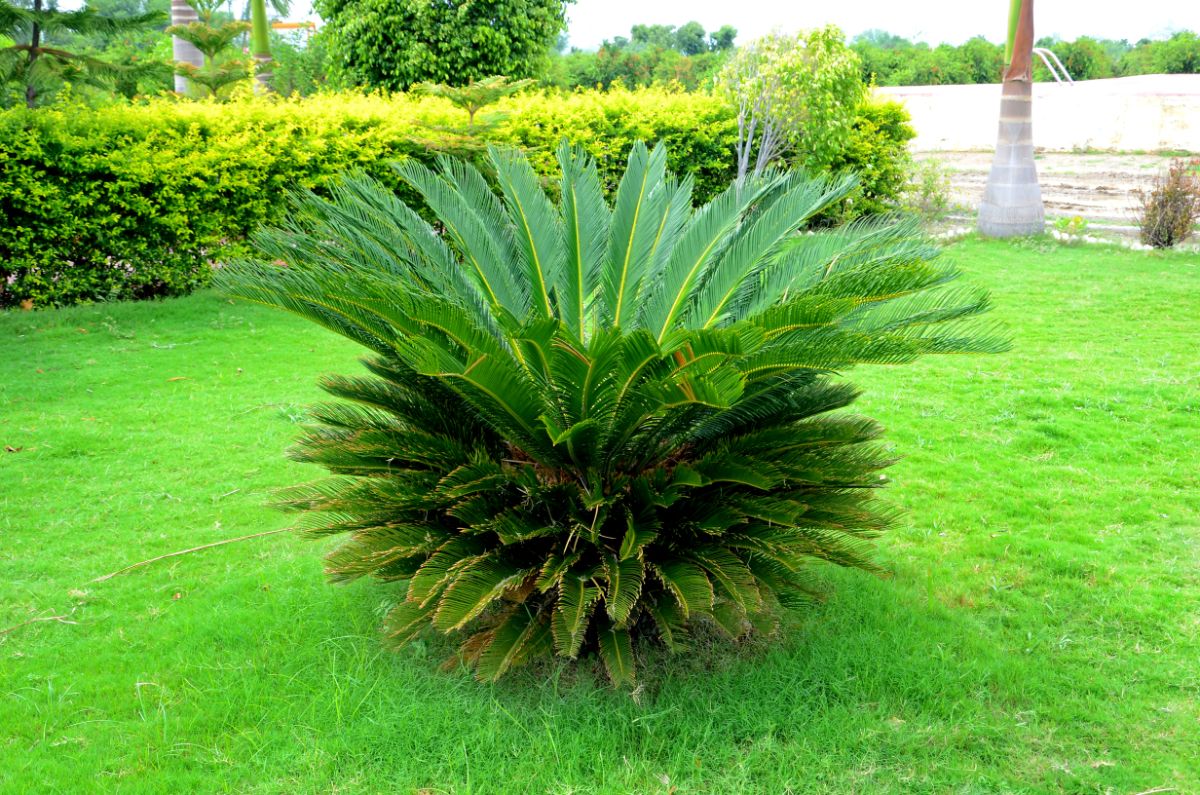
| Hardiness Zone: | 8-10 (USDA) |
| Water: | Allow the soil to dry out completely between watering in the winter and the top few inches of the soil to dry between watering in warmer months |
| Sun: | Grows best in partial shade |
The Japanese Sago Palm is a beautiful addition to any indoor plant collection or outdoor garden and, despite its name, is not actually considered a palm.
This feathery plant has beautiful green foliage and can tolerate much shadier conditions than true palms.
Just be careful not to overwater as the sago palm is susceptible to root rot.
13. Bromeliad (Bromeliaceae)
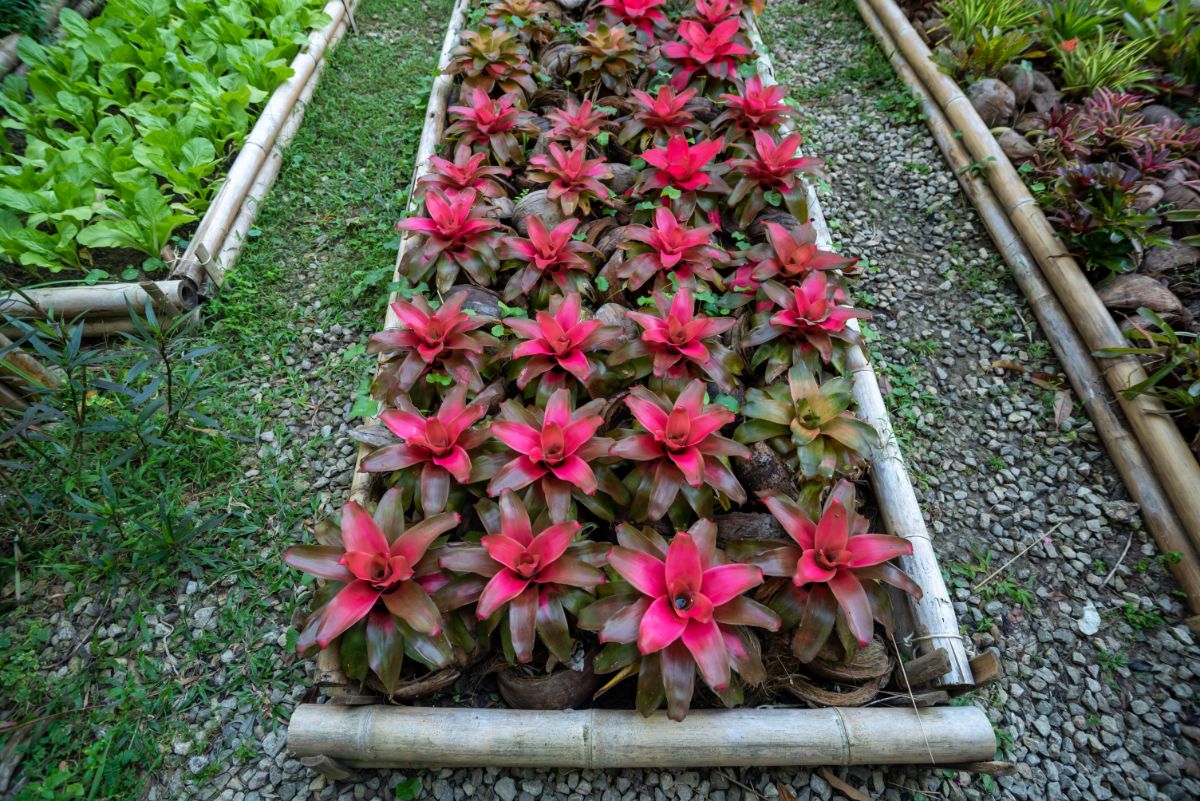
| Hardiness Zone: | 9-11 (USDA) |
| Water: | Thrives in bright, indirect but is tolerant of lower light conditions |
| Sun: | Depends on the variety |
Those fortunate enough to have seen a bromeliad bloom understand just why these gorgeous plants are so desirable.
There are many different varieties of bromeliads, and they have different care requirements. However, many bromeliad types can do very well in low light conditions.
In order to bloom, most bromeliads need at least partial, indirect light, but your bromeliad may be perfectly healthy even if it never flowers!
14. Alocasia Silver Dragon (Alocasia baginda)
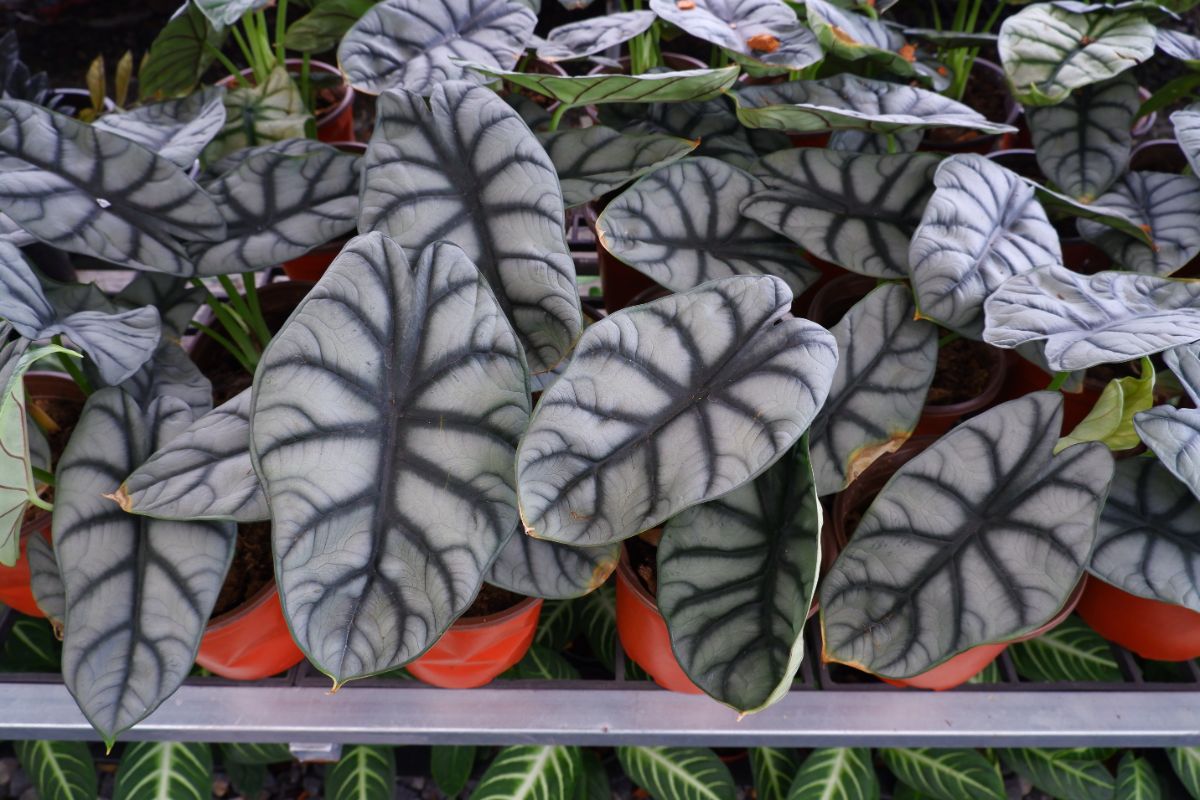
| Hardiness Zone: | 9-11 (USDA) |
| Water: | Water as soon as the top of the soil is dry to the touch |
| Sun: | Thrives in bright, filtered sunlight but is sensitive to too much light |
Although the gorgeous alocasia silver dragon requires some sunlight to survive, it made this list because of its sensitivity to too much light.
These plants simply cannot handle bright light and can grow and thrive so long as there is even a small amount of indirect, filtered light.
Just remember to rotate your alocasia regularly, as uneven plant growth can ruin the aesthetic!
15. Orchid (Orchidaceae)
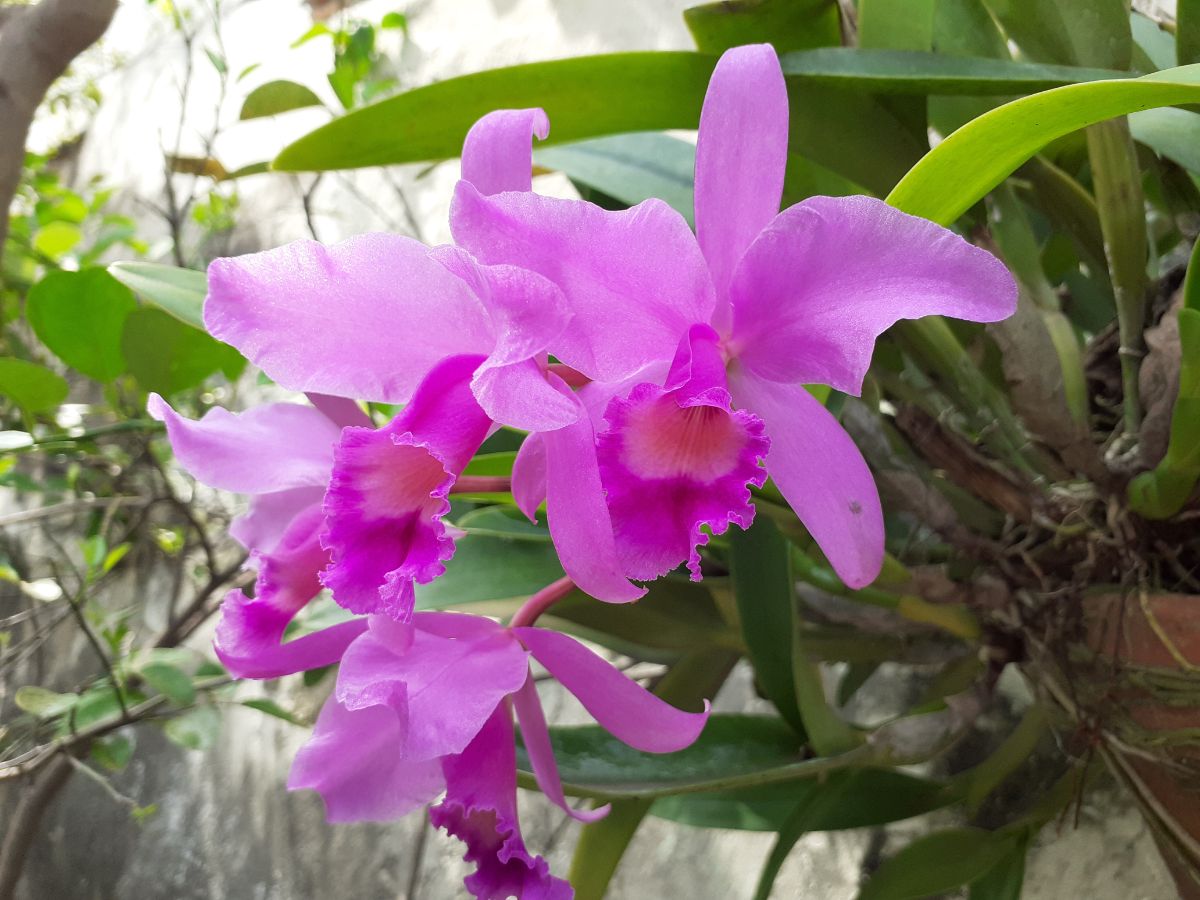
| Hardiness Zone: | Hardy orchids: 6-9 (USDA), Half-hardy orchids: 11 (USDA) |
| Water: | Allow the soil to dry out completely between watering |
| Sun: | Thrives in bright, indirect light |
While you may be surprised to hear that orchids made this list of plants that can survive without sunlight, orchids are very durable plants.
Orchids require a hefty amount of sunlight to thrive and bloom, but their growth pattern without sunlight emulates orchids that have entered dormancy.
The plant will continue to grow and show dark, hearty leaves, but no flowers will bloom. When you eventually move it somewhere more sunny, your orchid will happily bloom once again!
16. Money Tree (Pachira aquatica)

| Hardiness Zone: | 10-11 (USDA) |
| Water: | Allow the soil to dry out completely between watering |
| Sun: | Thrives in bright, indirect light but can tolerate lower light conditions |
Known for their ornamental braided trunks when grown as houseplants, money trees are low-maintenance and make great additions to your houseplant collection or outdoor garden.
These cheery plants tend to grow up to six feet when grown indoors but can reach heights upwards of 60 feet when planted outside!
Like the alocasia silver dragon, optimum growth requires you to regularly turn your money tree to ensure the plant is even on all sides.
17. Parlor Palm (Chamaedorea elegans)
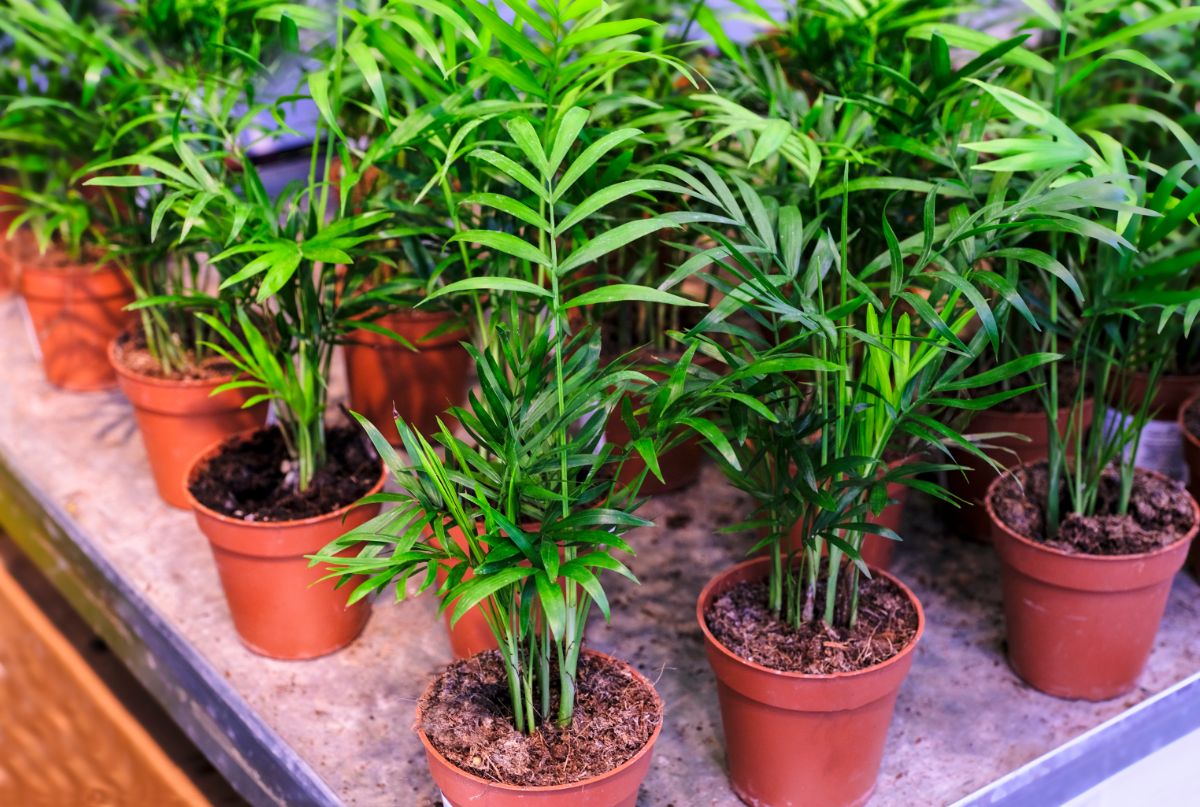
| Hardiness Zone: | 10-12 (USDA) |
| Water: | Allow the soil to dry out completely between watering |
| Sun: | Thrives in bright, indirect light but can tolerate lower light conditions |
The parlor palm is a very popular indoor plant, and its delicate and beautiful foliage almost resembles a very large fern.
While it thrives in areas where it receives a generous dose of sunlight, the parlor palm can survive and tolerate areas where it receives significantly less light.
18. Silver Satin (Scindapsus pictus)
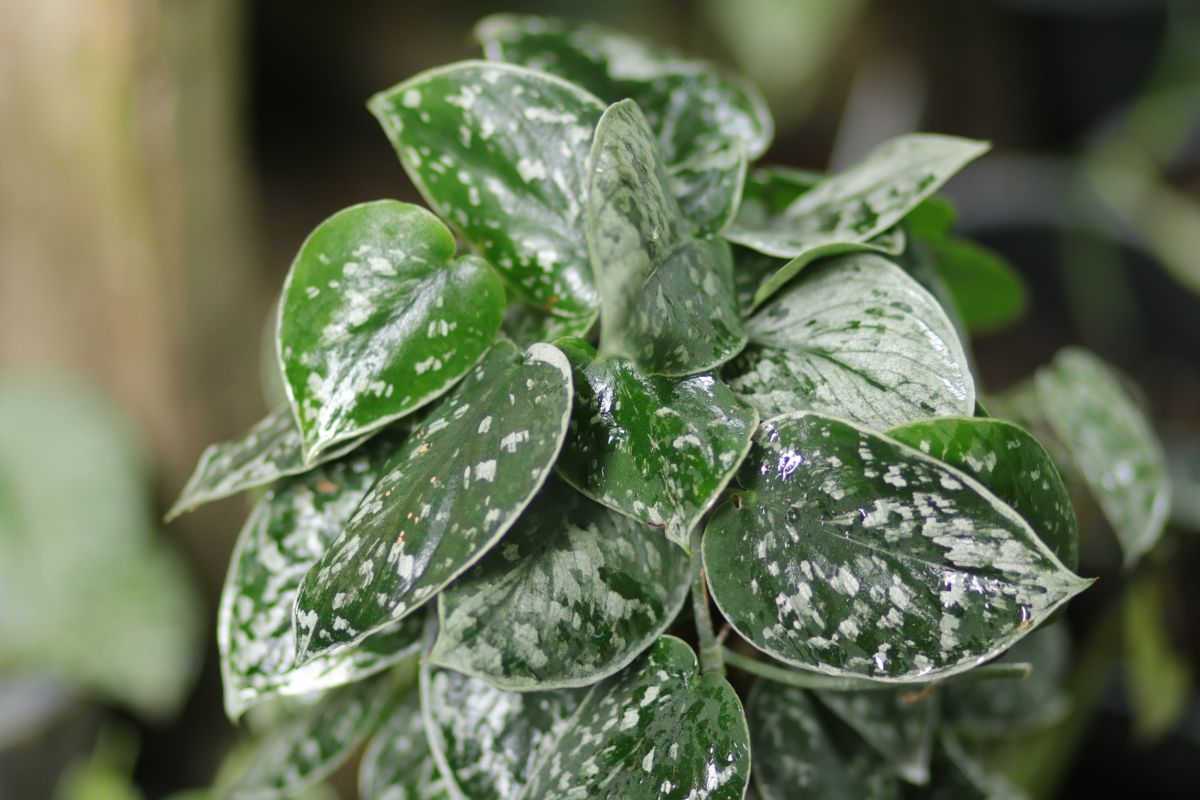
| Hardiness Zone: | 9-11 (USDA) |
| Water: | Water plant once the top few inches of the soil feel dry |
| Sun: | Thrives in bright, indirect light but can tolerate lower light conditions |
Like the golden pothos, the silver satin pothos thrives in areas where it’s receiving bright, indirect light and can grow abundantly.
Defined by their gorgeous green leaves with dotted silver-green variegation, these pothoses may simply grow less quickly without as much access to sunlight.
19. Panda Plant (Kalanchoe tomentosa)

| Hardiness Zone: | 9-11 (USDA) |
| Water: | Allow the soil to dry out completely between watering |
| Sun: | Thrives in bright, indirect light but can tolerate lower light conditions |
The panda plant, also called chocolate soldier or pussy’s ears because of its fuzzy stems and dappled brown tips, is a precious succulent that grows well with very little light!
Like most succulents, the panda plant does best when you let the soil dry out completely, as they’re prone to root rot.
20. Boston Fern (Nephrolepis exaltata)
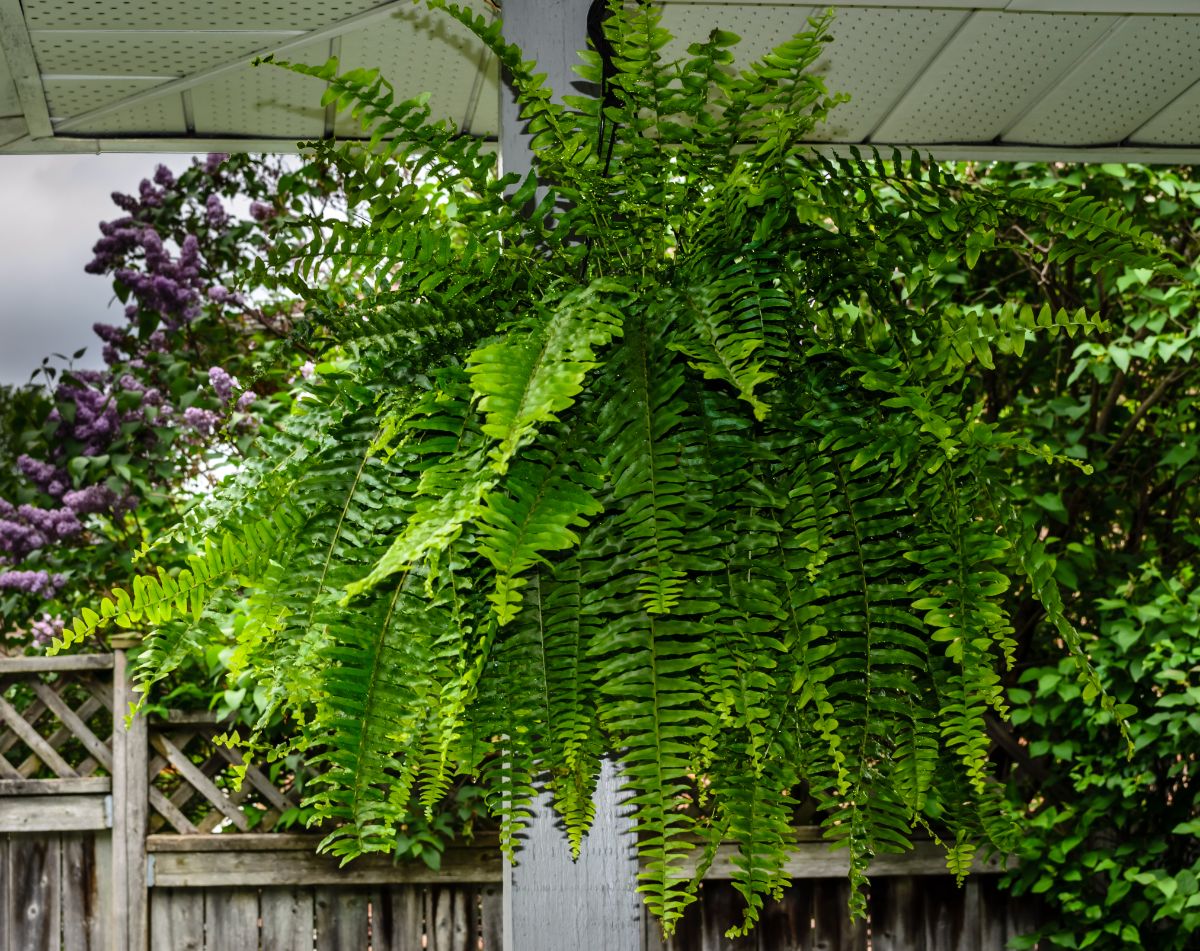
| Hardiness Zone: | 9-11 (USDA) |
| Water: | Keep the soil moist but not wet, water when you notice it begins to dry out |
| Sun: | Thrives in bright, indirect light but can tolerate lower light conditions |
Boston ferns make great plants because of their versatility. While they do great as a part of your landscaped yard, they also thrive indoors or outside in hanging containers.
Like the maidenhair fern, it’s essential to keep the soil moist for your Boston fern to stay happy and healthy, but it is more tolerant of drought than its more delicate relative.
21. English Ivy (Hedera helix)
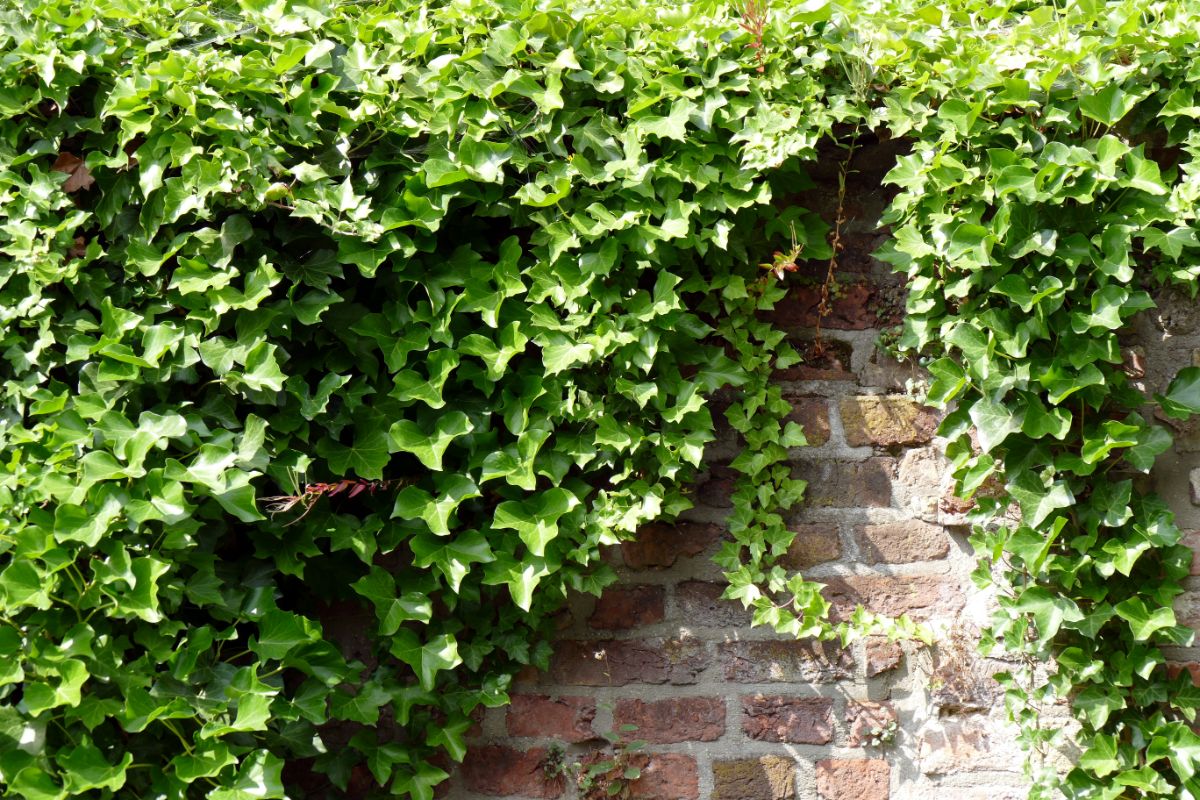
| Hardiness Zone: | 4-13 (USDA) |
| Water: | Water when the top few inches of soil are dry |
| Sun: | Thrives in partial to complete shade |
While you may think of English ivy as a trailing vine growing up the sides of trees or buildings, it also makes an excellent houseplant.
Easy to grow and very hardy, English ivy is sure to add some appeal to your home or garden and can grow even in the shadiest of conditions.
22. Laceleaf (Anthurium spp.)

| Hardiness Zone: | 10-13 (USDA) |
| Water: | Keep the soil moist but not wet, water when you notice it begins to dry out susceptible to root rot |
| Sun: | Thrives in bright, indirect light but can tolerate lower light conditions |
Laceleaf is a family of plants that are known for their dark, glossy leaves and striking flowers, called spathes. The spathes come in various colors, with a conical spadix jutting out of it.
Be aware that your laceleaf may take longer to grow and flower less regularly when grown with less sunlight.
23. Dumb Cane (Dieffenbachia)
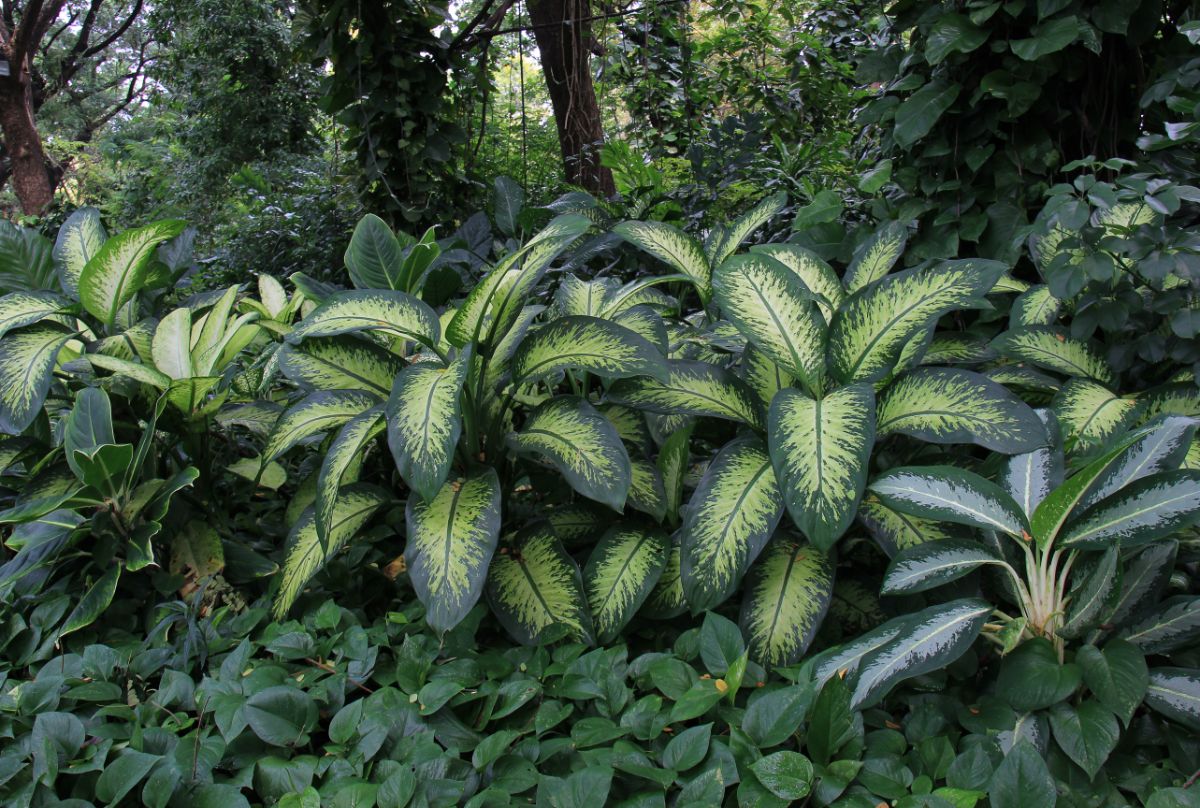
| Hardiness Zone: | 10-12 (USDA) |
| Water: | Water when the top few inches of the soil are dry |
| Sun: | Can handle bright, indirect light or partial shade |
Dumb cane is a low-maintenance houseplant that is appealing because of its ability to grow in various lighting conditions.
While tolerant of low lighting, dumb cane still offers aesthetic appeal with its trademark dappled, variegated leaves.
24. Sword Fern (Polystichum munitum)
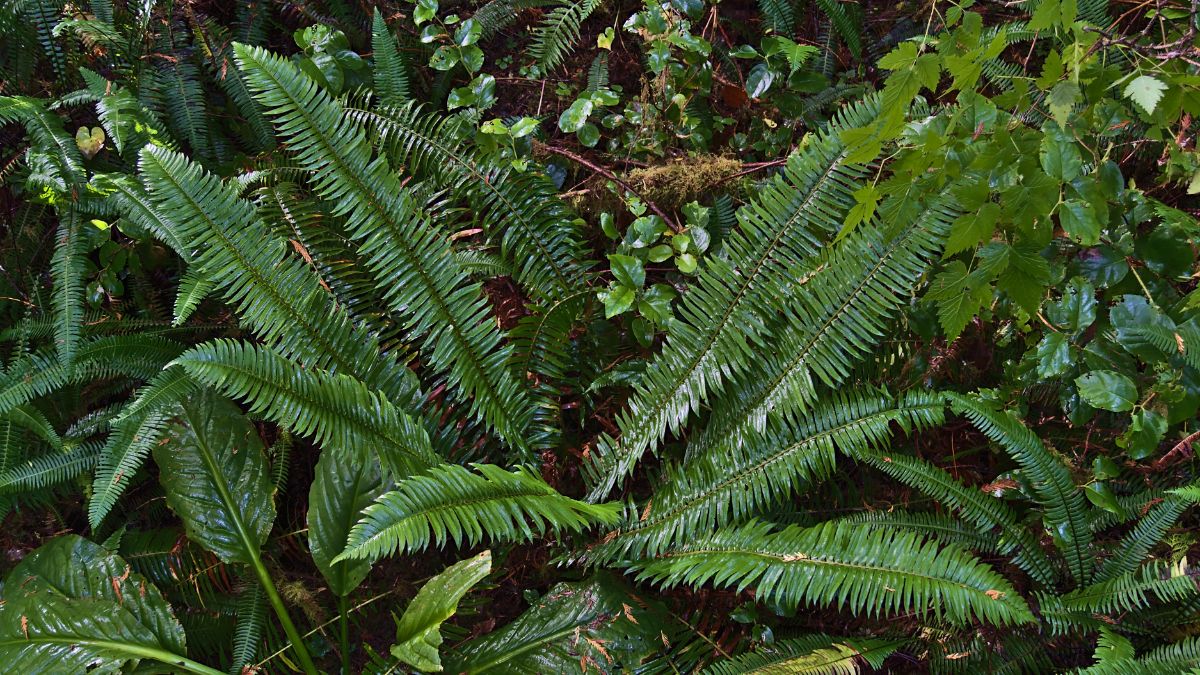
| Hardiness Zone: | 5-9 (USDA) |
| Water: | Keep the soil moist not wet, water when you notice it begins to dry out |
| Sun: | Thrives in partial to complete shade |
A classic beauty and a plant that you are likely to see when looking at the forest floor, the sword fern is a hardy plant that can handle practically no sunlight.
When grown outdoors, they thrive in shady, moist areas, and so long as their soil is kept moist enough and they aren’t exposed to harsh sunlight, they make attractive houseplants.
25. The Paper plant (Fatsia Japonica)
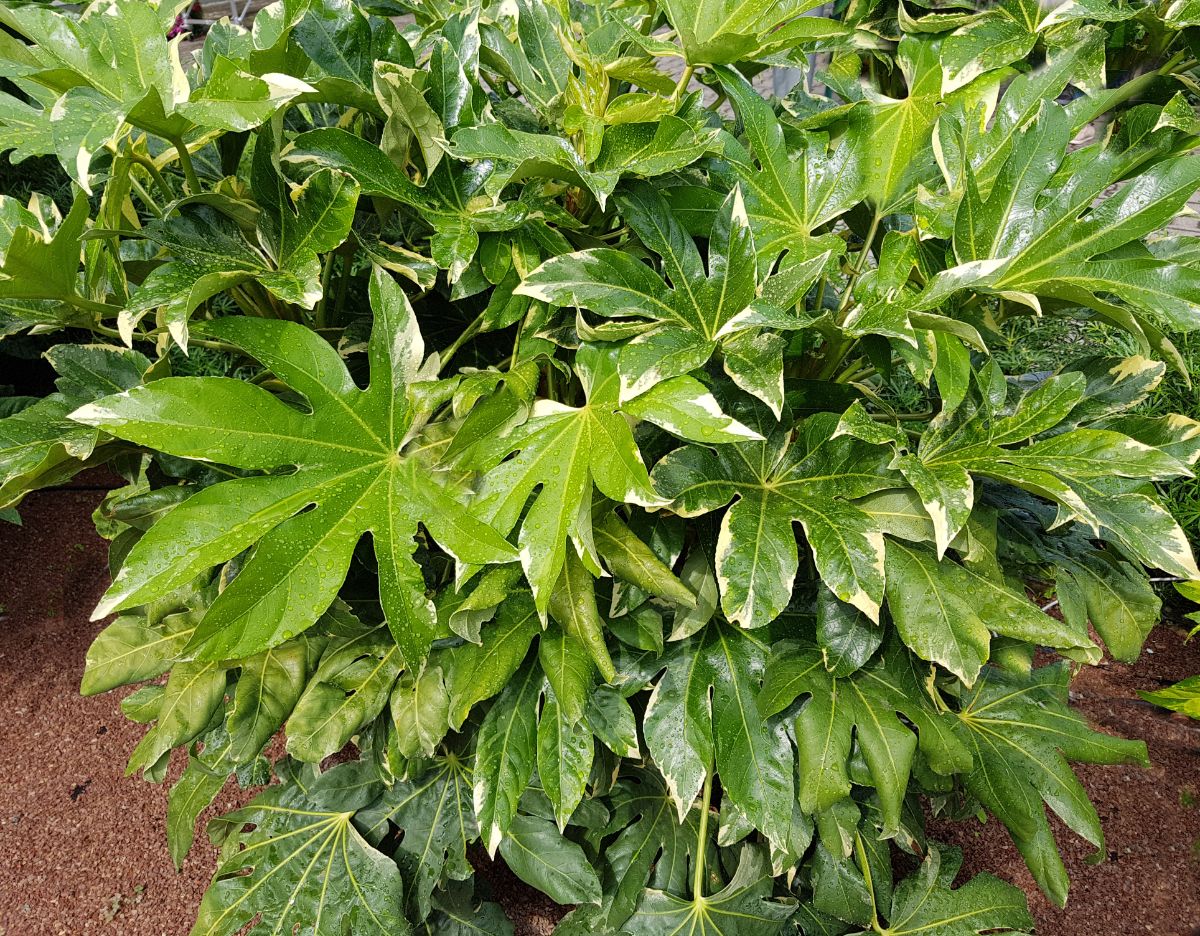
| Hardiness Zone: | 7-9 (USDA) |
| Water: | Water thoroughly, draining excess water to avoid root rot |
| Sun: | Thrives in partial to complete shade |
Paper plants make excellent shade plants because, unlike many other plants, they actually thrive without bright sunlight.
While many of the plants on this list will grow in shaded areas, this growth may be significantly reduced compared to if they were given sunlight.
On the other hand, the paper plant will reward you with fast, beautiful growth, even in complete shade.
26. Dwarf Umbrella Tree (Schefflera arboricola)
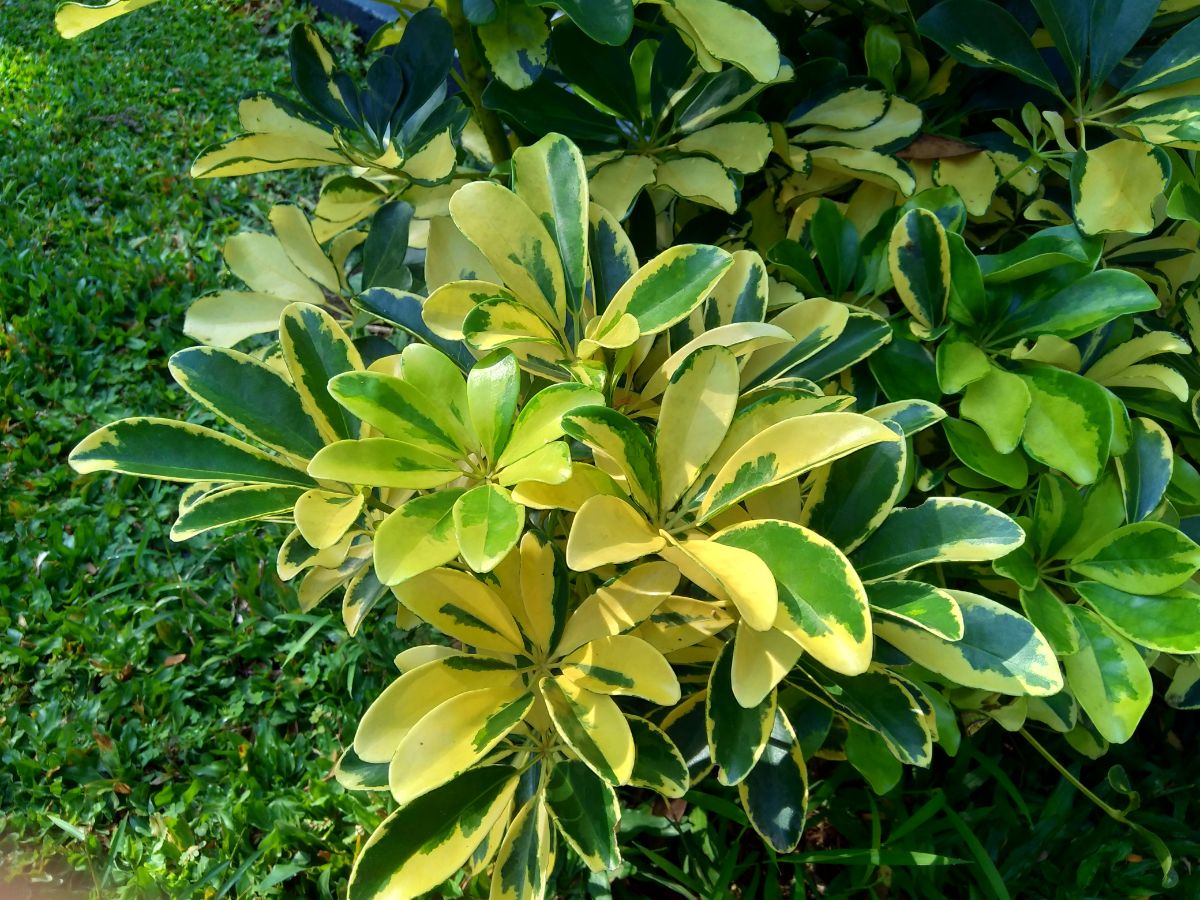
| Hardiness Zone: | 10-11 (USDA) |
| Water: | Water thoroughly, then allow the soil to dry out completely between watering |
| Sun: | Thrives in bright, indirect light but can tolerate lower light conditions |
The dwarf umbrella tree is an attractive, low-maintenance houseplant that resembles the money tree physically.
It offers plant owners fast growth and bushy foliage, although it’s best to turn it regularly.
While the dwarf umbrella tree tolerates lower light, the stems may get spindly without enough indirect light.
27. Lucky Bamboo (Dracaena sanderiana)
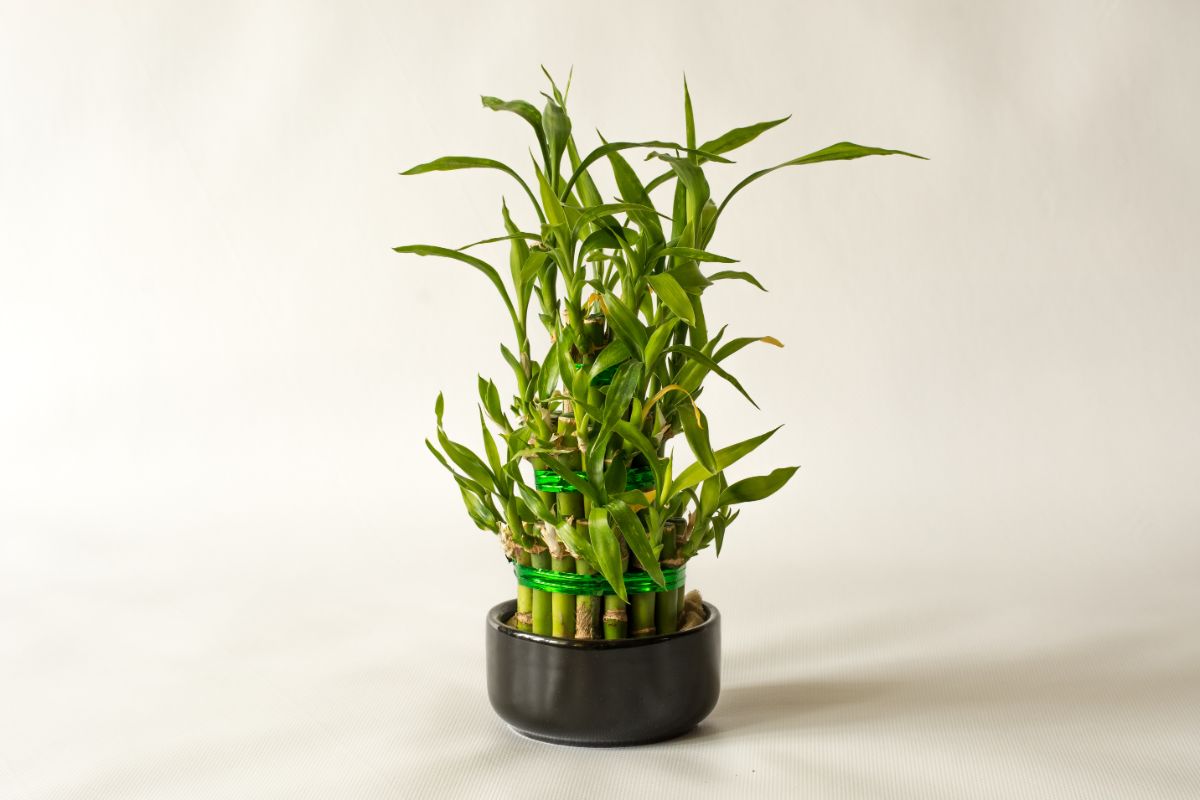
| Hardiness Zone: | 10-12 (USDA) |
| Water: | Grow in water or soil that you water regularly to keep it moist |
| Sun: | Thrives in bright, indirect light but can tolerate lower light conditions |
Lucky bamboo is a beautiful and very low-maintenance plant, said to bring luck to the plant owner.
Assuming the roots have enough space to grow, the lucky bamboo can grow simply in water, so long as there are not too many chemical additives (such as fluoride).
28. Arrowhead Plant (Syngonium podophyllum)
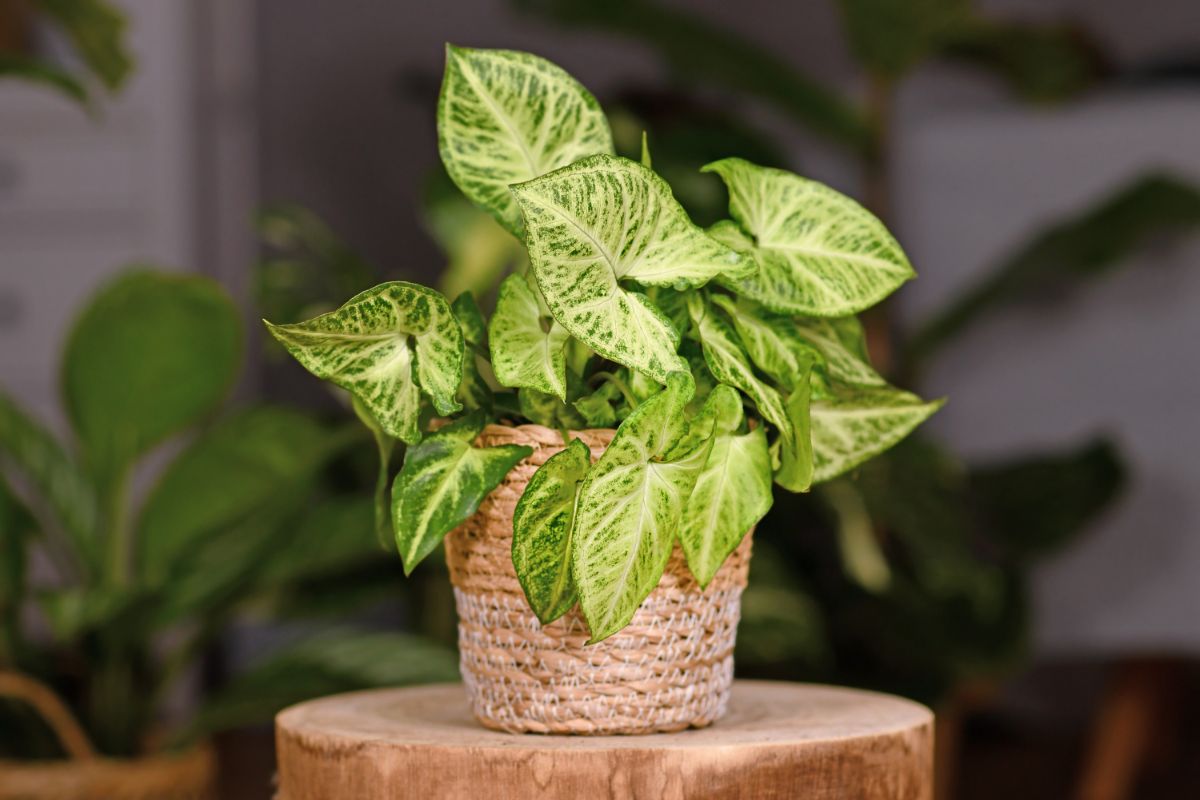
| Hardiness Zone: | 10-12 (USDA) |
| Water: | Water plant once the top few inches of soil feel dry |
| Sun: | Depends on the variety, but most are tolerant of partial shade, while only some can handle bright sunlight |
The arrowhead plant is named so because of the arrowhead shape of the leaves. It is a small, bushy plant that can add charm to both indoor and outdoor gardening.
The arrowhead plant comes in several varieties, offering distinct colors.
29. Swiss Cheese Plant (Monstera deliciosa)
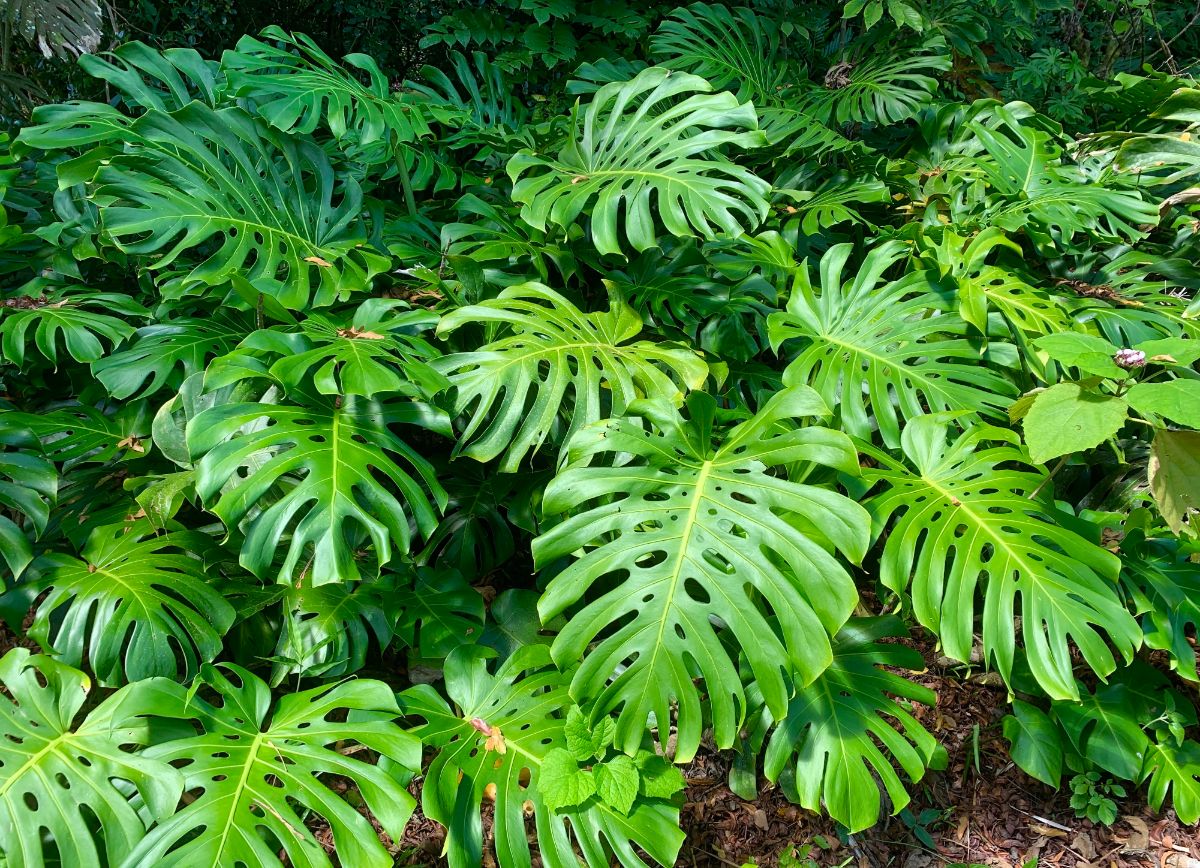
| Hardiness Zone: | 10-12 (USDA) |
| Water: | Water thoroughly, draining excess water to avoid root rot |
| Sun: | Thrives in medium to bright indirect light but can handle low light conditions |
The swiss cheese plant, also commonly called a split-leaf philodendron or simply a monstera, is one of the top coveted houseplants.
Relatively easy to care for and tolerant of lower lighting, you can keep your indoor swiss cheese plant particularly happy by placing it in the shower for thorough waterings that emulate the tropical weather in the rainforests to which it is native.
30. Staghorn Fern (Platycerium)
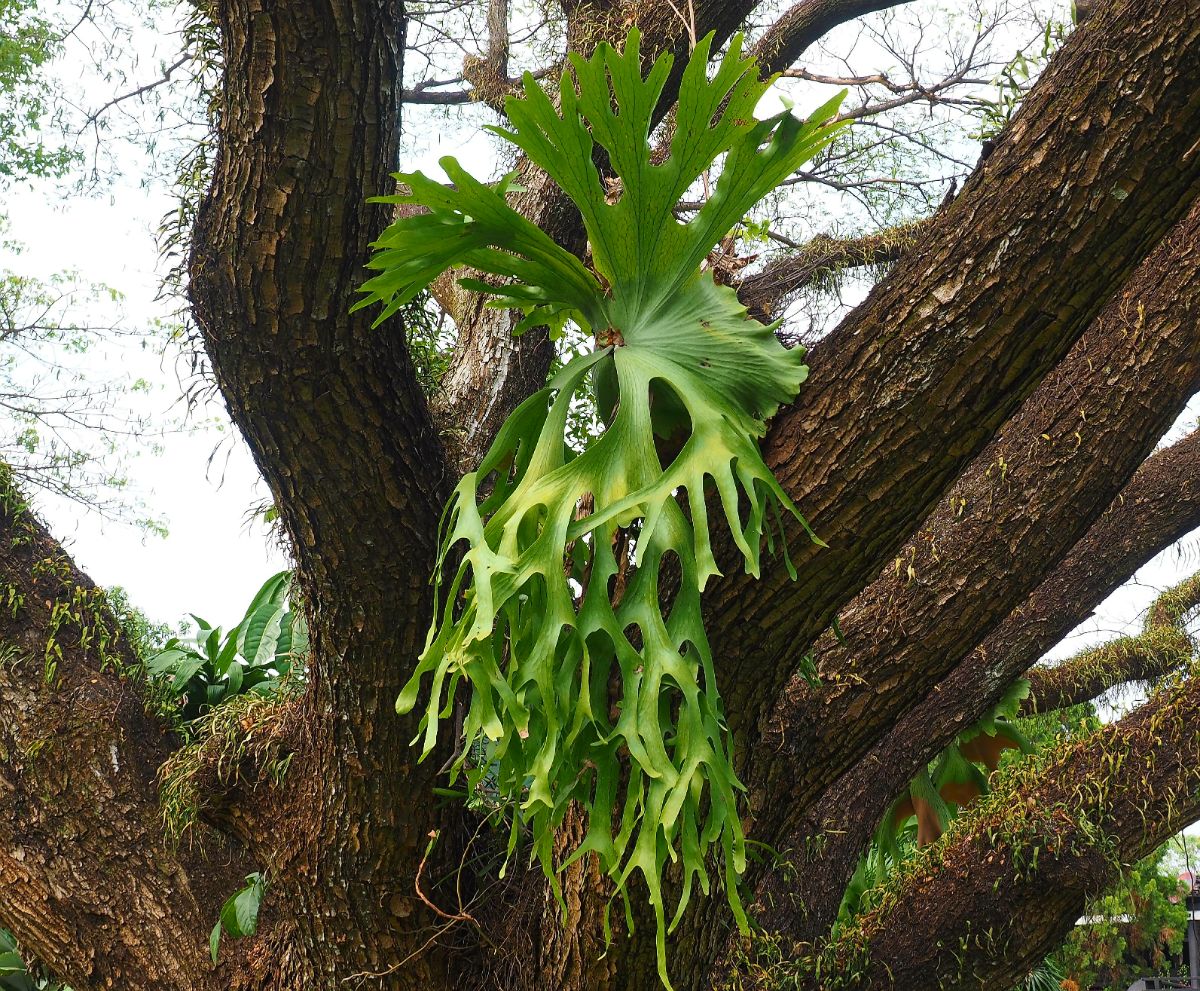
| Hardiness Zone: | 9-12 (USDA) |
| Water: | Water thoroughly, then allow the soil to dry out almost completely between watering |
| Sun: | Partial to complete shade, will require significantly more water and humidity to tolerate brighter, indirect light |
Staghorn ferns are popular both indoors and outdoors because of their uniquely beautiful epiphytic nature.
The staghorn fern is often seen mounted on wall plaques because it emulates their natural habit of growing on trees.
31. Creeping Fig (Ficus pumila)
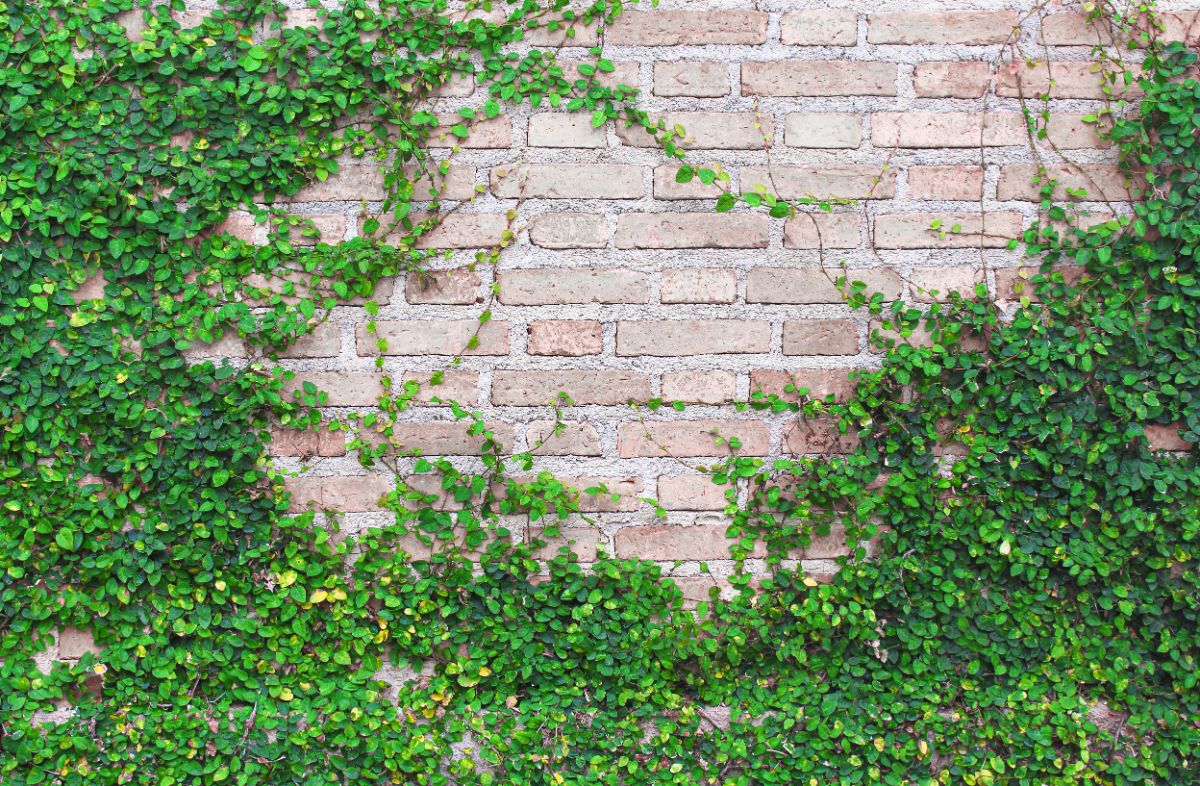
| Hardiness Zone: | 9-11 (USDA) |
| Water: | Water thoroughly, then allow the soil to dry completely between watering |
| Sun: | Thrives in bright, indirect light but can tolerate lower light conditions |
Creeping figs are known for their tiny, delicate foliage that can be a dark, rich green color or even variegated.
Outdoors this plant is a steady grower and can be seen creeping up the sides of buildings.
If you choose to keep your creeping fig indoors, prepare for its growth to be less impressive and only live a few years, although it is sure to be beautiful while it lasts!
32. Zebra Cactus (Haworthia attenuata)
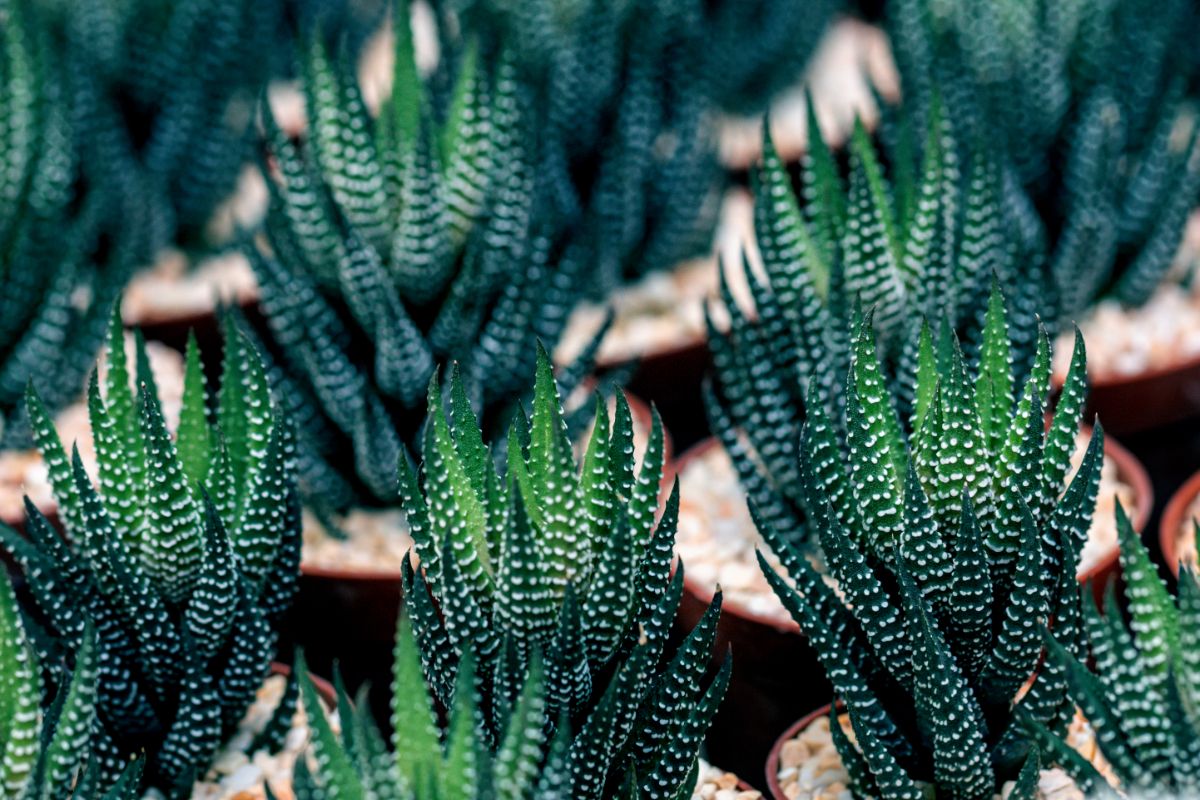
| Hardiness Zone: | 9-11 (USDA) |
| Water: | Allow the soil to dry out completely between watering, be careful to avoid overwatering |
| Sun: | Thrive in medium to bright, indirect light but can tolerate lower light conditions |
The zebra cactus is one of the cutest and most visually stunning plants on the list. This succulent is defined by its dark green stems with white ridges, resembling the stripes of a zebra.
While it thrives with some sunlight, the zebra plant is somewhat tolerant of shade, but if you notice its green stems begin to fade, consider moving it somewhere with slightly more sun.
33. Cast Iron Plant (Aspidistra elatior)

| Hardiness Zone: | 8-10 (USDA) |
| Water: | Allow the soil to dry out completely between watering |
| Sun: | Can handle partial, indirect sunlight, partial shade to complete shade |
The cast iron plant is for you if you possess the opposite of a green thumb. These plants are virtually indestructible, are incredibly tolerant of neglect, and require almost no sunlight to survive.
Whether you plant them inside or outdoors, feel free to choose any area that doesn’t receive too much sunlight, and your cast iron plant will continue to reward you with its rich, green foliage.
34. Weeping Fig (Ficus benjamina)
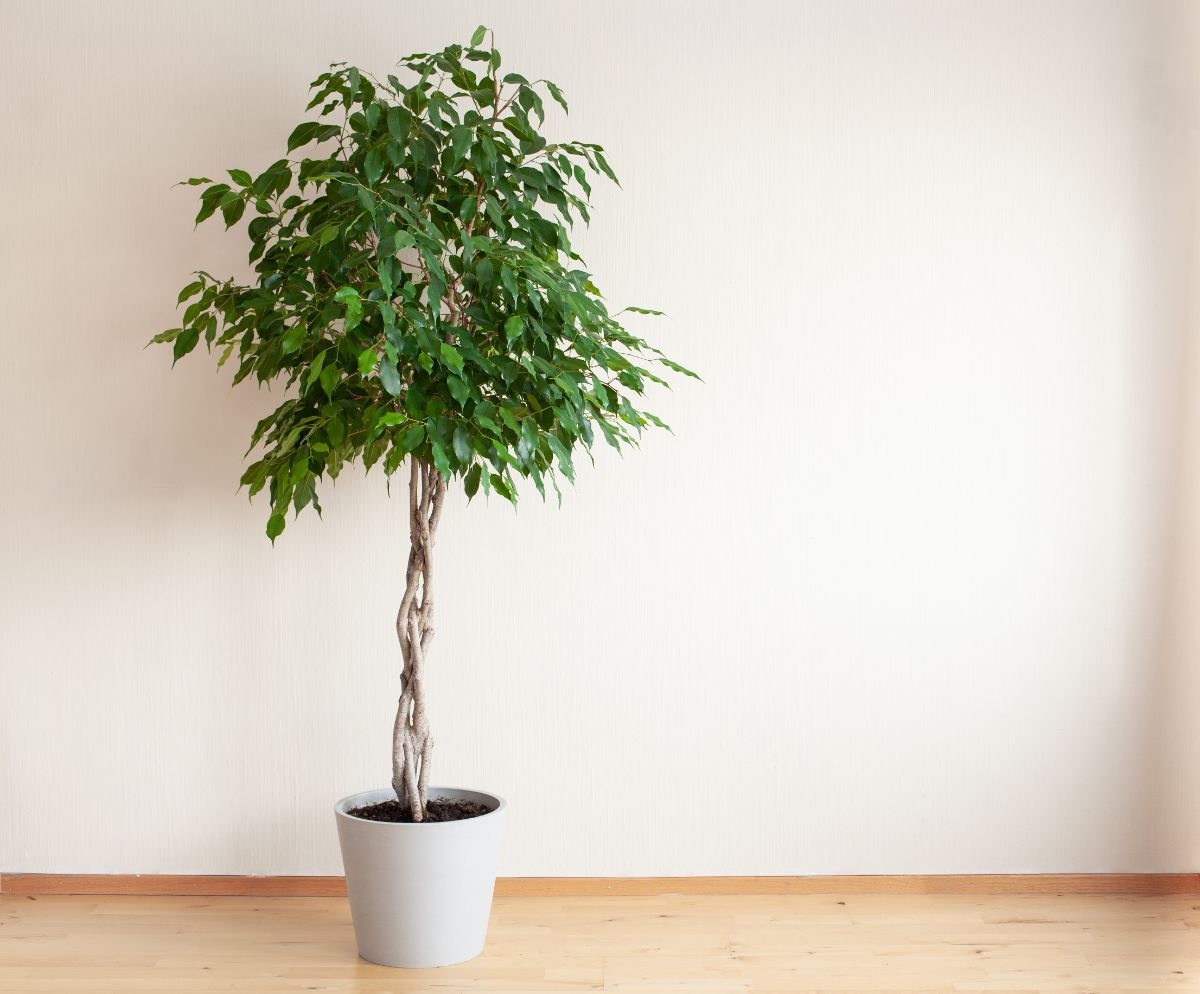
| Hardiness Zone: | 9-11 (USDA) |
| Water: | Water when the soil just starts to dry out, the soil should be kept moist, not wet |
| Sun: | Thrives in bright, indirect sunlight but can tolerate lower light conditions |
The weeping fig is a stunning, petite tree with delicate weeping leaves. While beautiful, the weeping fig is one of the more high-maintenance plants on the list.
Consistency is key when caring for a weeping fig, and they can tolerate uniform, lower levels of sunlight.
35. Wax Plant (Hoya)
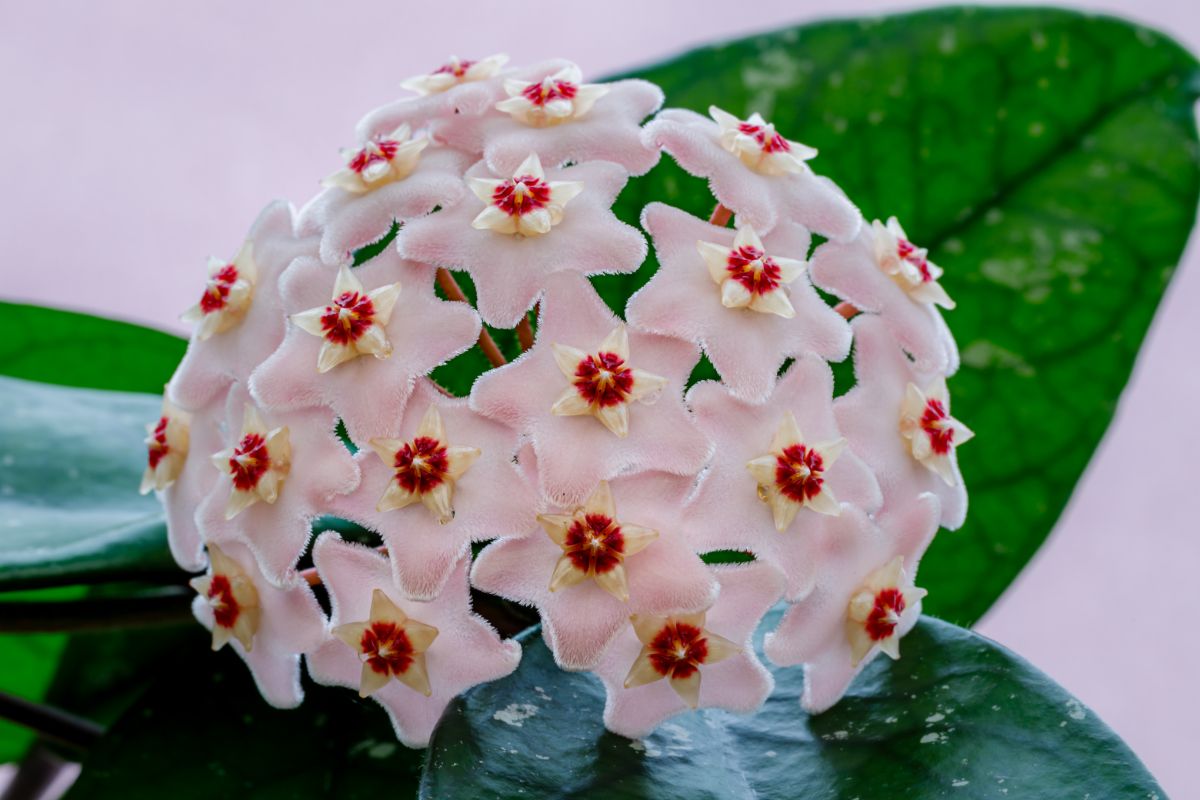
| Hardiness Zone: | 9-11 (USDA) |
| Water: | Water consistently when the soil begins to dry out so that the soil is kept moist, not wet |
| Sun: | Depends on the variety, but thypically thrive in bright, indirect light, although they are tolerant of more shaded areas |
Wax plants make great houseplants because of their woody stocks and beautiful, turgid leaves. They come in many varieties and are relatively easy to care for.
Depending on what type of wax plant you own, they may have different light requirements, but many hoya varieties can handle partial shade.
36. Bird’s Nest Fern (Asplenium nidus)
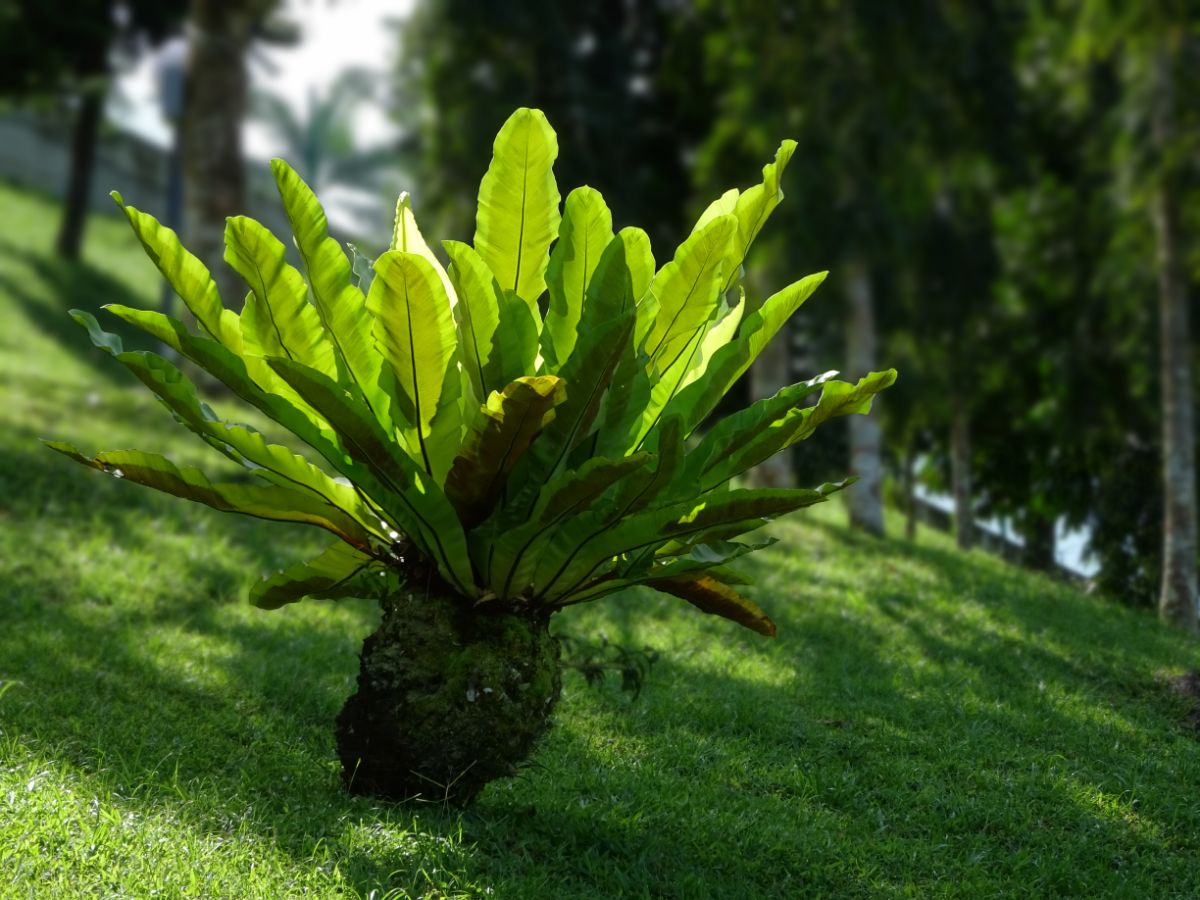
| Hardiness Zone: | 11-12 (USDA) |
| Water: | Keep the soil moist but not wet, water when you notice it begins to dry out |
| Sun: | Thrives in partial shade |
Bird’s nest ferns are lovely and unique, and while their care is similar to some of the other ferns on this list, they are distinctly tropical.
Their bright green leaves are broad and wavy, and in their natural habitat, they grow on trees, like the staghorn fern.
Find a nice, shaded area for your bird’s nest ferns to thrive.
37. Elephant Ear (Colocasia esculenta)

| Hardiness Zone: | 8-11 (USDA) |
| Water: | Water thoroughly and never allow the soil to dry out, soil should fell moist to the touch at all times |
| Sun: | Thrives in partial shade but is tolerant of most light conditions |
The elephant ear, also called taro, is a fun plant that will add appeal whether planted indoors or outside.
They have broad, striking leaves that grow quite large, and these plants thrive in lower light conditions.
Elephant ears thrive in moist soil, making it an excellent choice for those who tend to overwater their plants!
38. Dragon Tree (Dracaena)
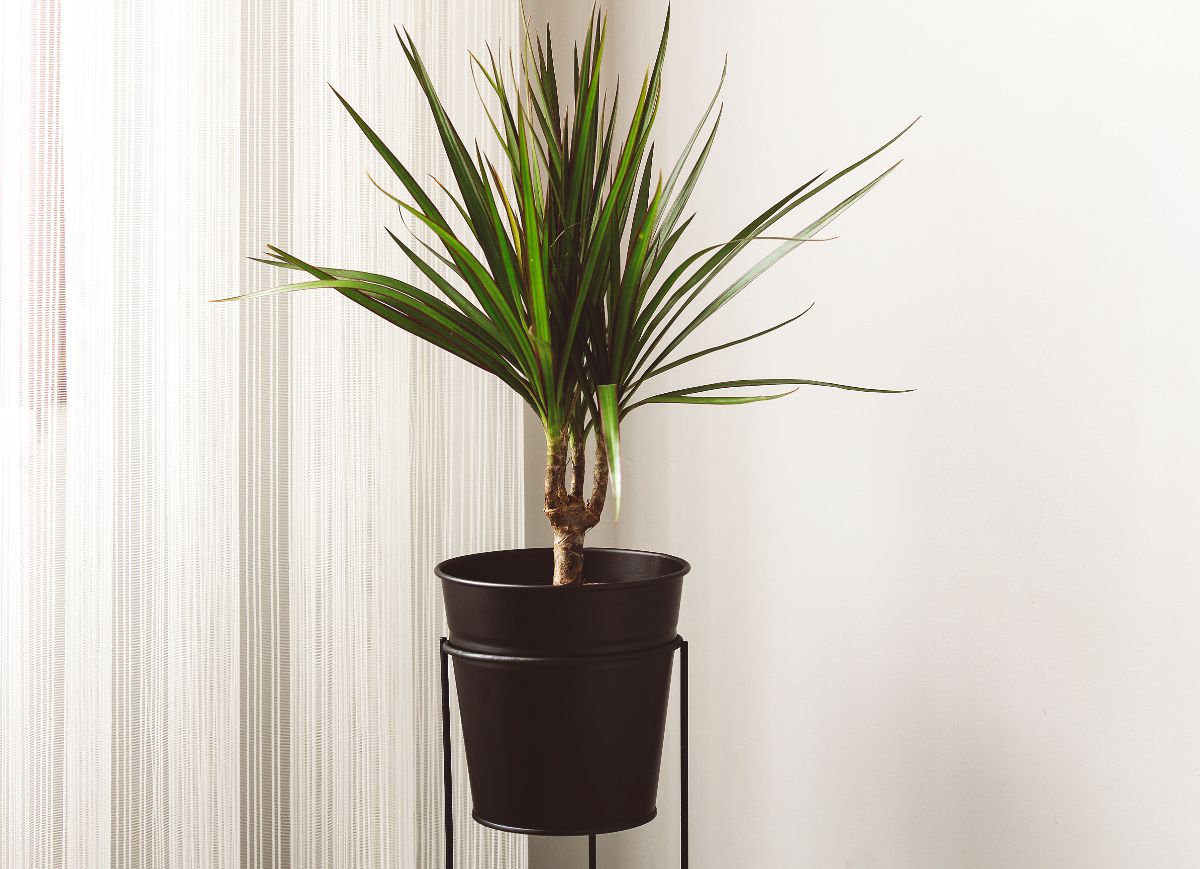
| Hardiness Zone: | 10-12 (USDA) |
| Water: | Water thoroughly and allow the soil to dry out until the top several inches are dry to the touch |
| Sun: | Thrives in bright, indirect light but is tolerant of lower light conditions |
Dragon trees make spectacular houseplants because they’re low-maintenance and typically grow with sharp, brightly-colored foliage to nearly six feet tall.
Dragon trees grow slowly but don’t require much sunlight and are relatively drought tolerant.
39. Christmas Cactus (Schlumbergera)
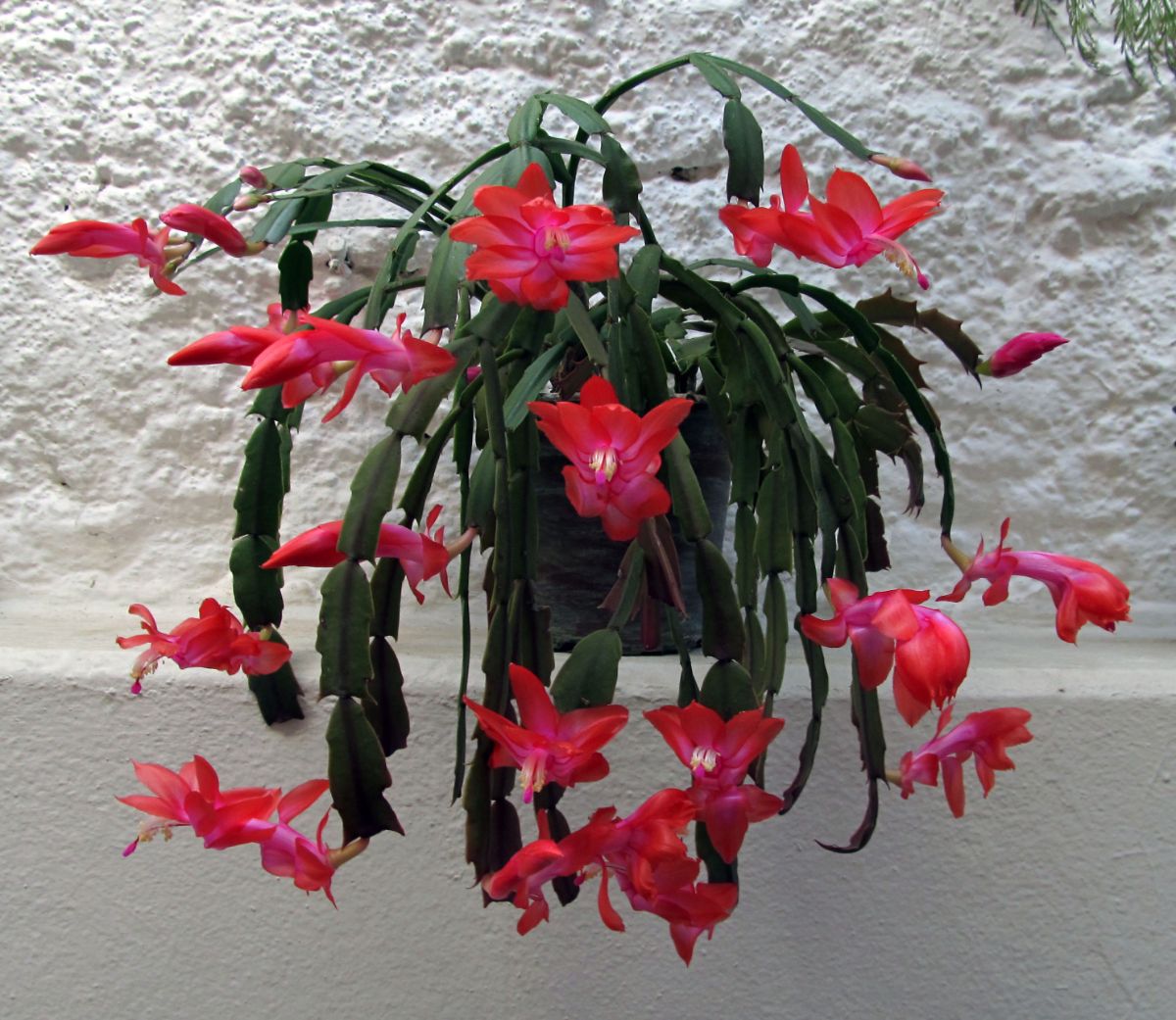
| Hardiness Zone: | 10-11 (USDA) |
| Water: | Water plant once the top few inches of soil feel dry |
| Sun: | Thrives in partially shaded areas |
The Christmas cactus is so named because it is the Schlumbergera variety that blooms closest to the Christmas holiday!
If you’ve seen Easter cactuses and Thanksgiving cactuses, these plants are in the same family but bloom closest to the holidays they’re named after.
40. Peace Lily (Spathiphyllum)
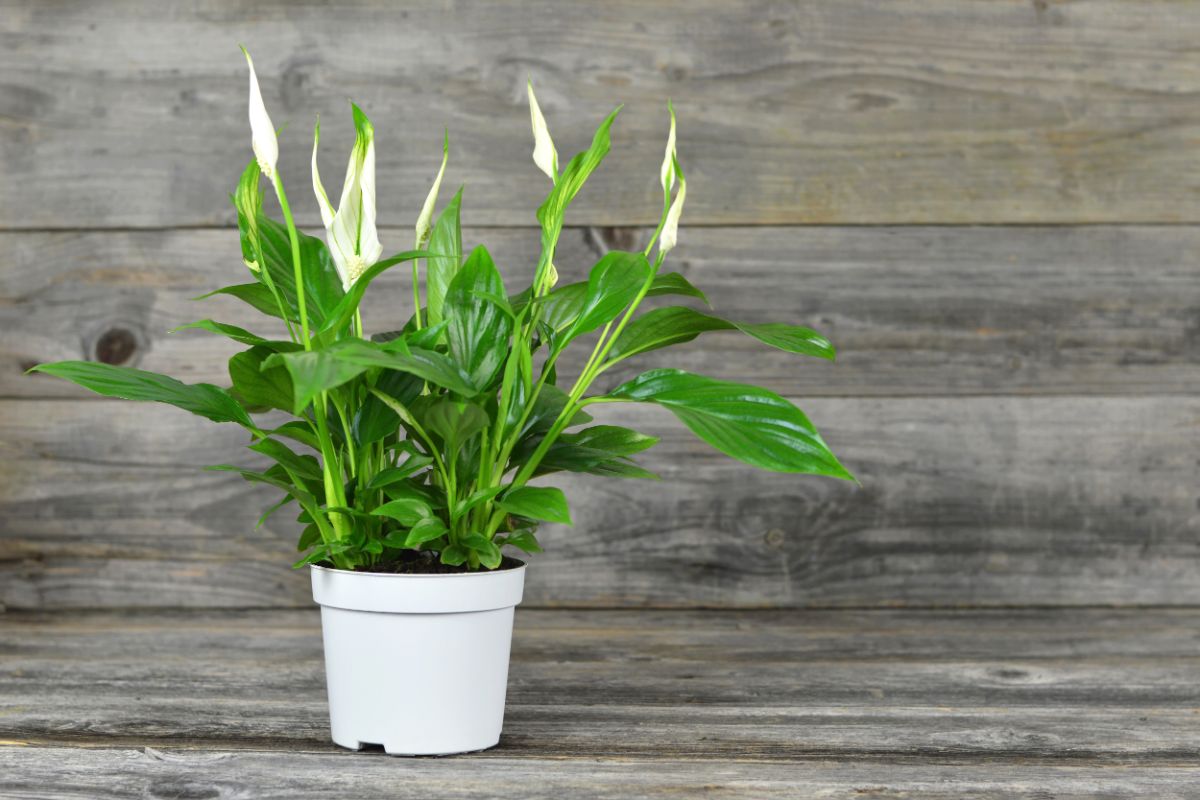
| Hardiness Zone: | 10-11 (USDA) |
| Water: | Keep the soil moist but not wet, water when you notice it begins to dry out |
| Sun: | Thrives in partially shaded areas but can handle complete shade |
Peace lilies are common when grown indoors and outdoors. They’re known for their dark, deep leaves and beautiful white flowers. Best of all? They’re very low-maintenance!
Be cautious when growing peace lilies if you own pets, as they’re toxic to both cats and dogs.
41. Spider Plant (Chlorophytum comosum)
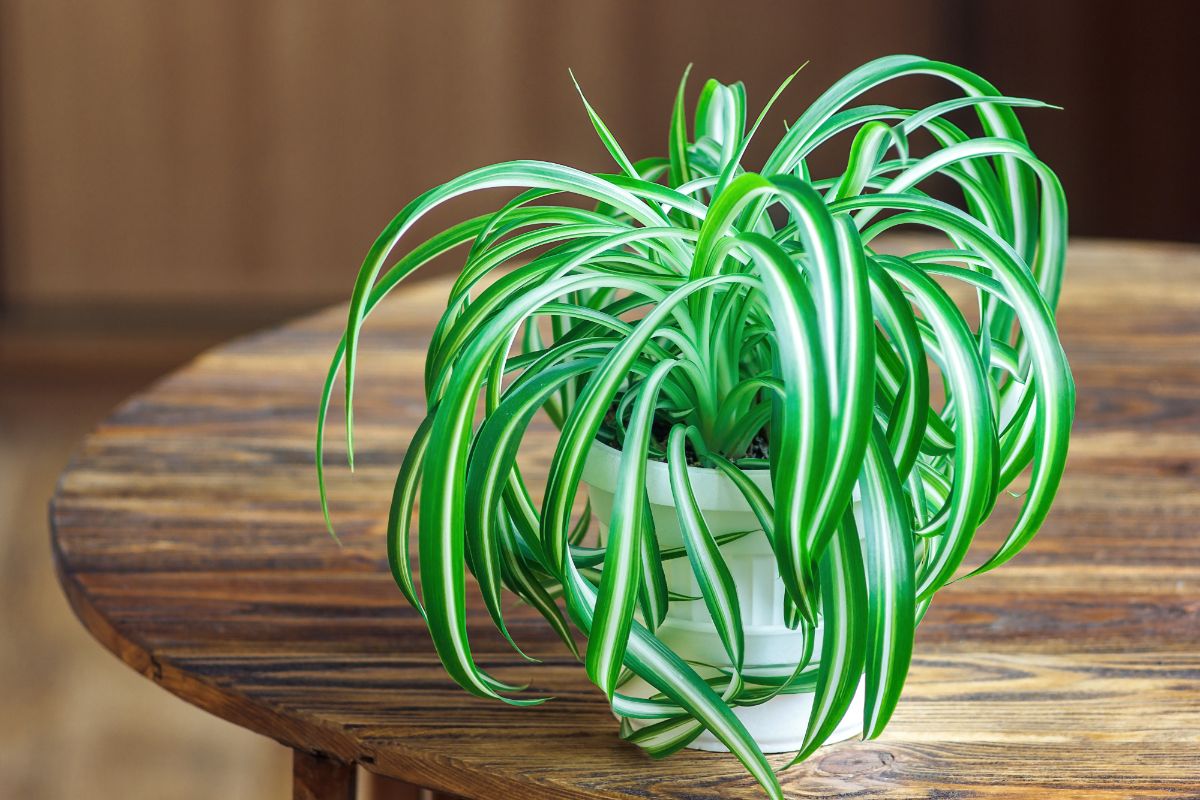
| Hardiness Zone: | 9-11 (USDA) |
| Water: | Water thoroughly and allow the top few inches of soil to dry out in between watering |
| Sun: | Thrives in partial shade but is tolerant of complete shade |
Spider plants are whimsical and easy to care for, often seen growing in hanging baskets. The plants grow smaller “baby” plants that hang from the parent plant and can be easily propagated and shared with friends!
42. Chinese Money Plant (Pilea peperomioides)
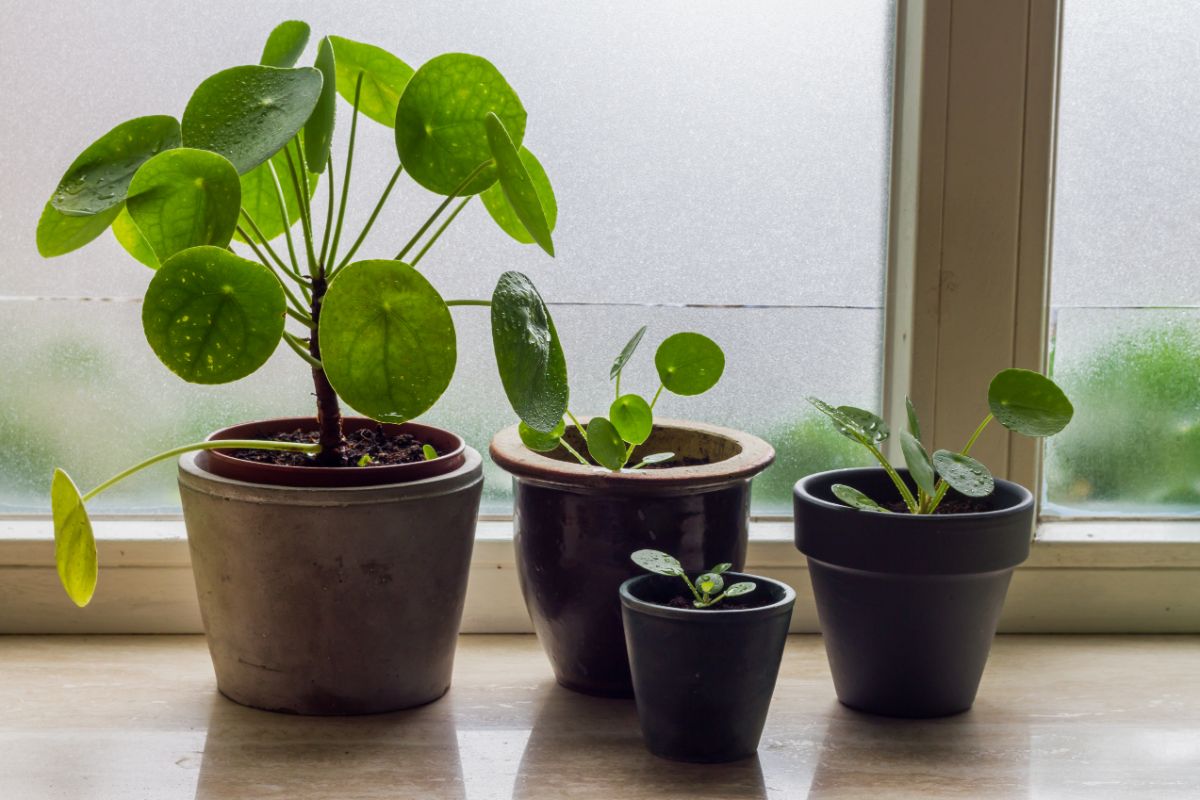
| Hardiness Zone: | 9-11 (USDA) |
| Water: | Water thoroughly, then allow the soil to dry out almost completely between watering |
| Sun: | Thrives in bright, indirect light but is tolerant of lower light conditions |
The Chinese money plant is an adorable, petite plant known for its light stalks and coin-shaped leaves.
When it has access to sunlight, regularly rotate the plant so it doesn’t look unbalanced. The Chinese money plant can survive with very little sunlight, but it may develop fewer, smaller leaves.
43. Fuschia (Fuschia)
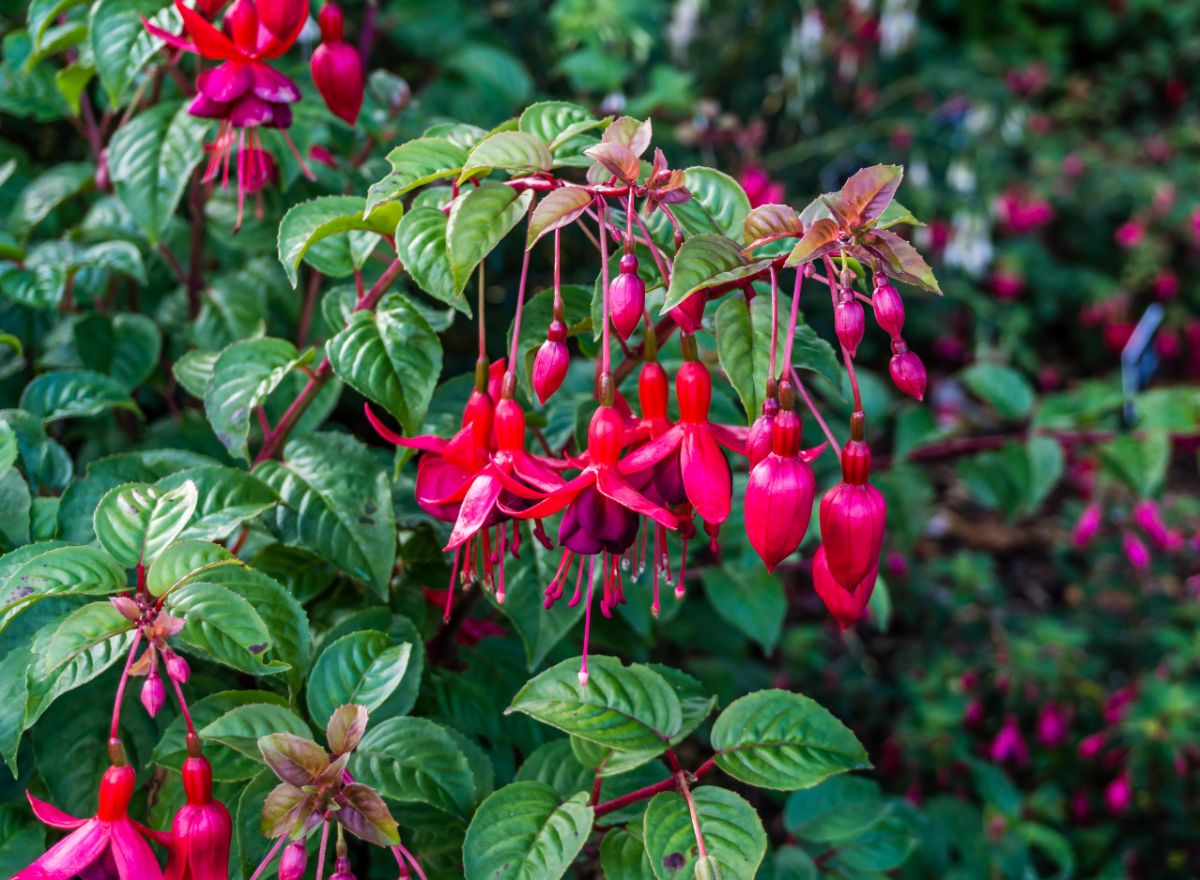
| Hardiness Zone: | 10-11 (USDA) |
| Water: | Water when the soil just start to dry out, the soil should be kept moist, not wet |
| Sun: | Thrives in partial shade but can tolerate lower light conditions |
Fuschias are often seen in hanging planters outside of people’s homes and in commercial landscaping.
Their gorgeous, bright-colored flowers are deeply alluring, and unlike many other plants, sunlight is not required for these beauties to bloom.
44. Aloe Vera (Aloe barbadensis miller)
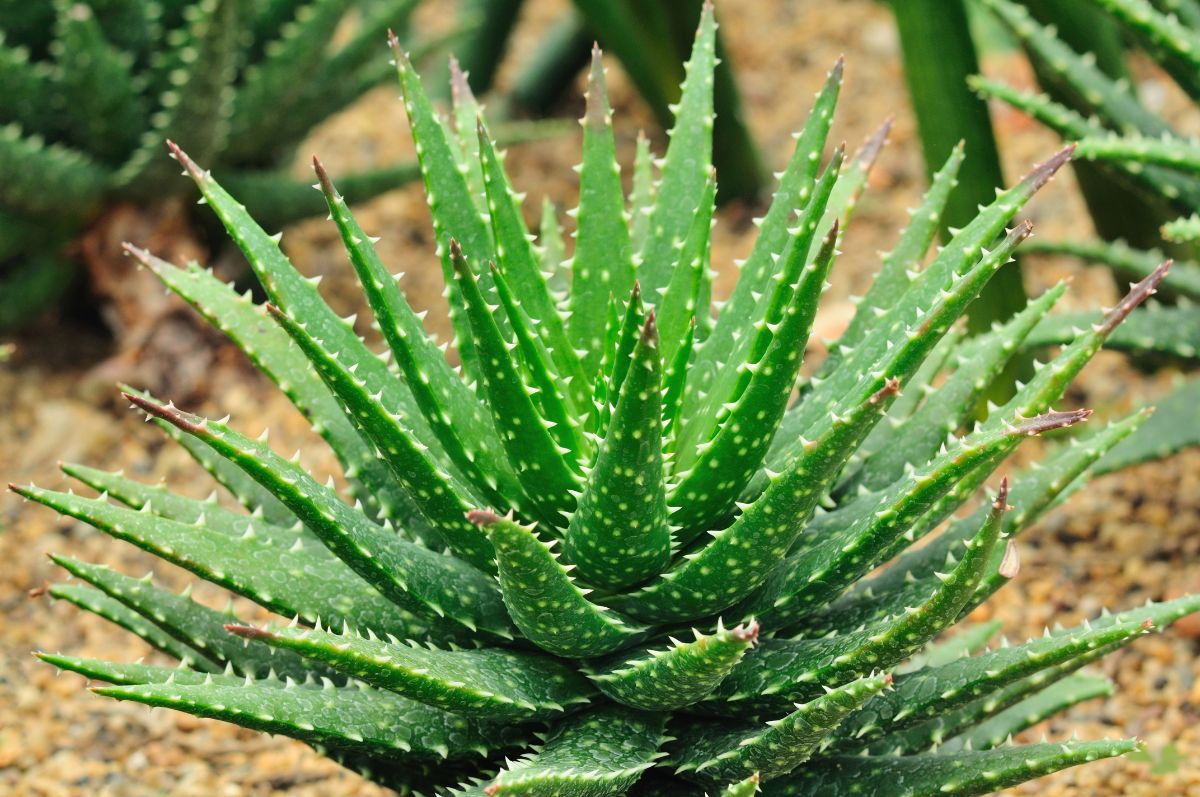
| Hardiness Zone: | 10-12 (USDA) |
| Water: | Allow the soil to dry out completely between watering, do not water during the dormant season |
| Sun: | Thrives in bright, indirect light but is tolerant of lower light conditions |
Did you know that aloe vera can be applied to your skin directly from the plant? If you have an aloe plant growing, it can offer you many benefits and save you a trip to the grocery store after a day in the sun!
45. Painted Leaf Begonia (Begonia rex)
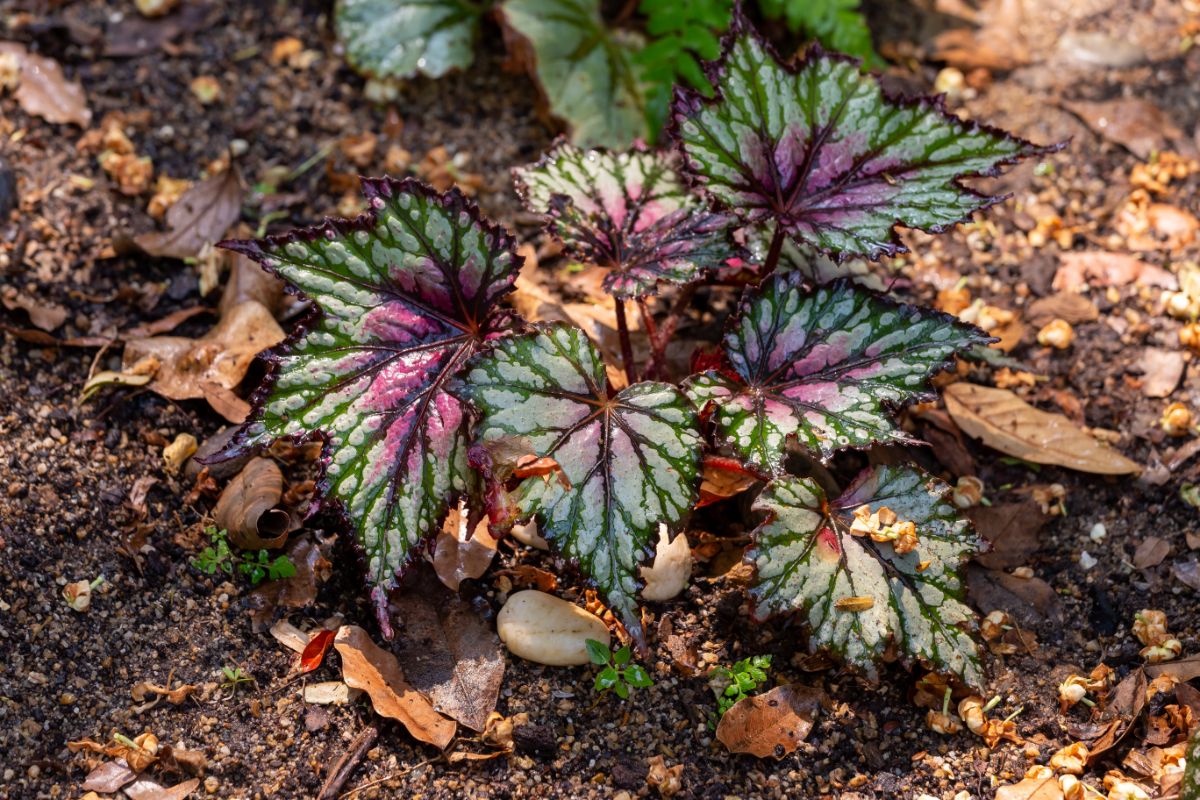
| Hardiness Zone: | 10-12 (USDA) |
| Water: | Water when the soil just start out to dry out, the soil should be kept moist, not wet |
| Sun: | Thrive in bright, indirect light but is tolerant of lower light conditions |
While many begonia varieties require more sunlight, the painted leaf begonia makes a fantastic, low-maintenance option because this plant is far more tolerant of low light conditions.
Painted leaf begonias are aptly named for their gorgeous, colorful mottled leaves.
Final Thoughts
If your home or apartment doesn’t get a lot of natural light, but you’re a plant lover, don’t fret! There are plenty of plants that can survive or even thrive in lower light areas.
While many houseplants prefer bright light, every plant on this list can do just fine in areas without access to direct sunlight.
Consider picking up one of these 45 plants today to brighten up and add some greenery to your space.

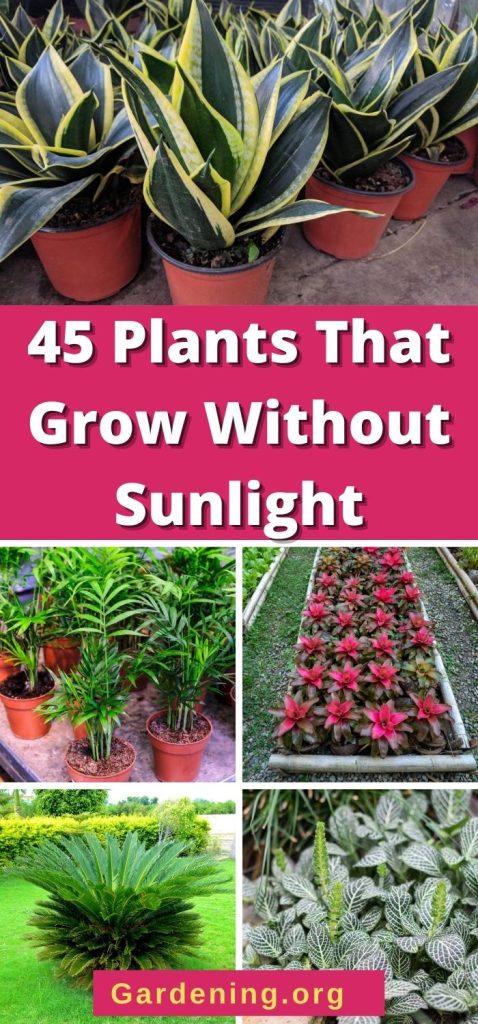

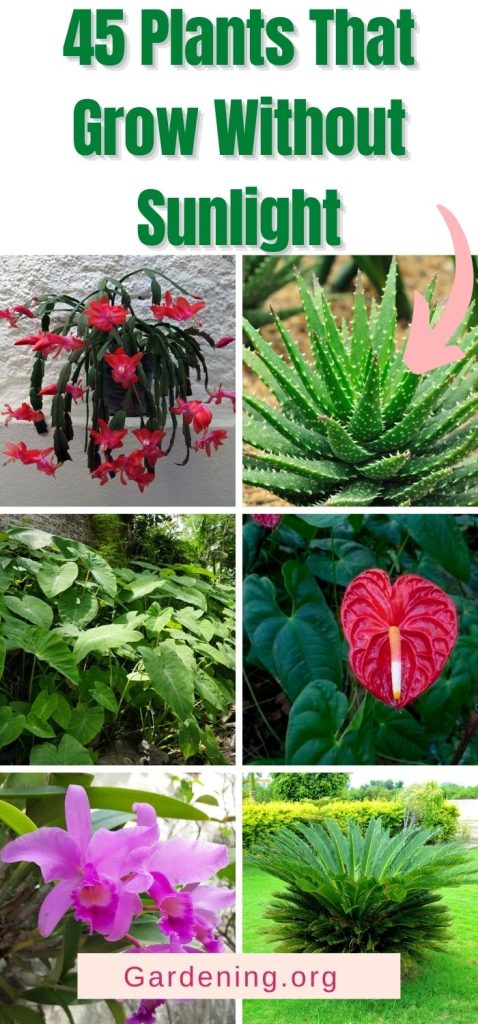
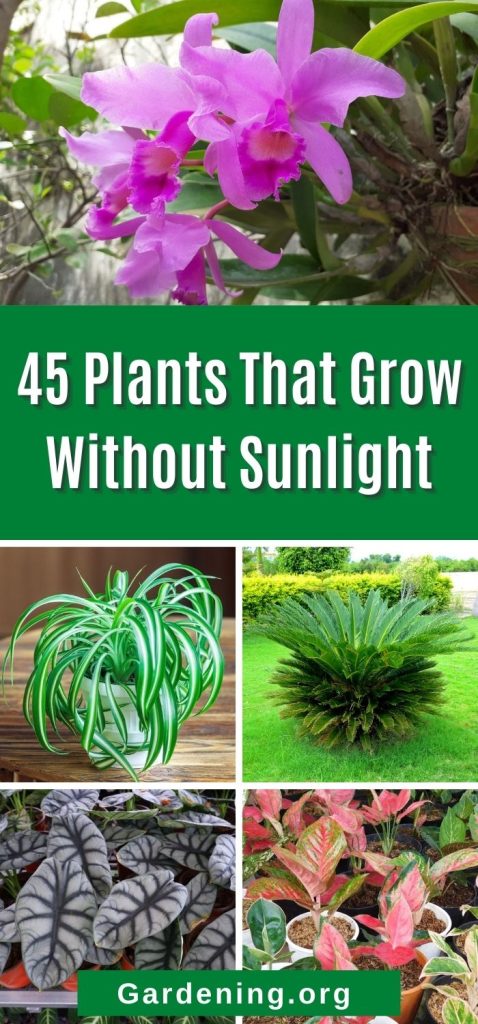
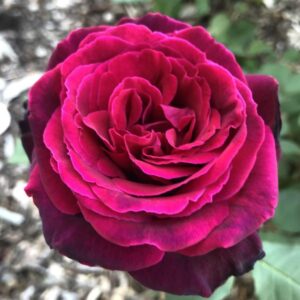
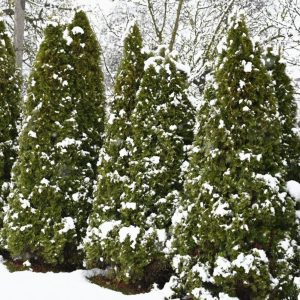


Leave a Reply